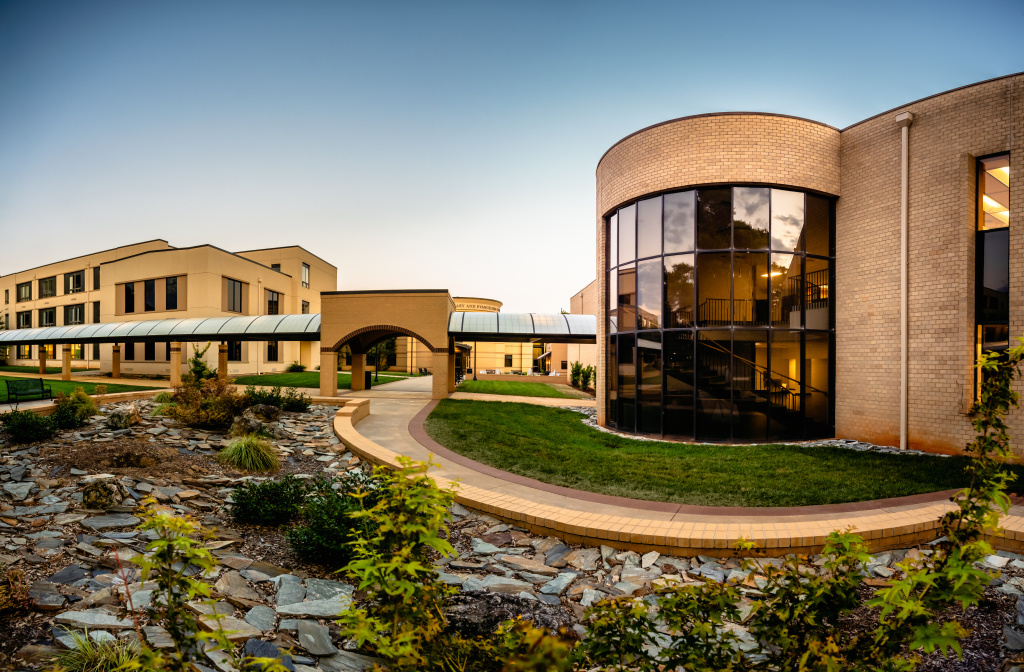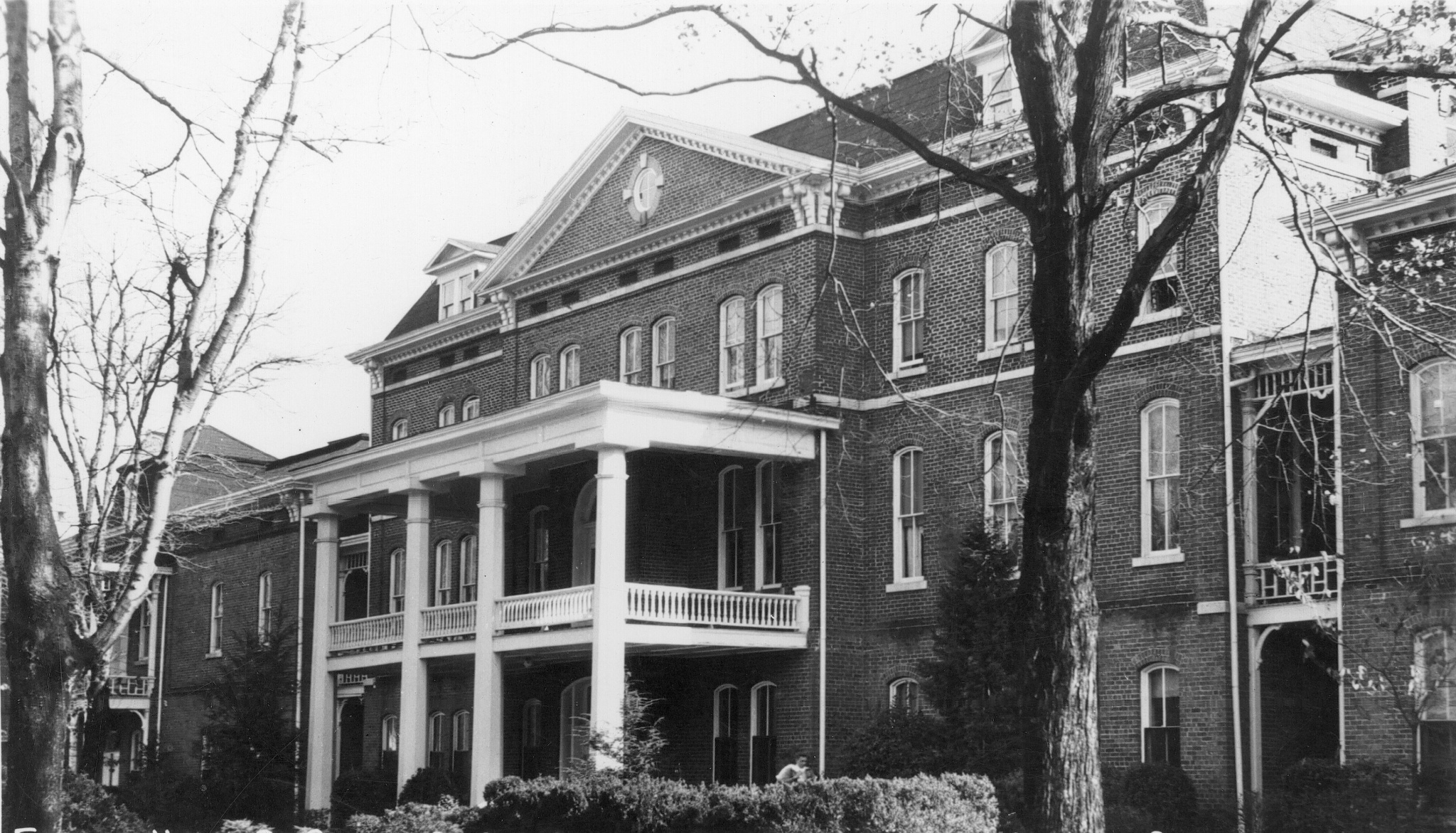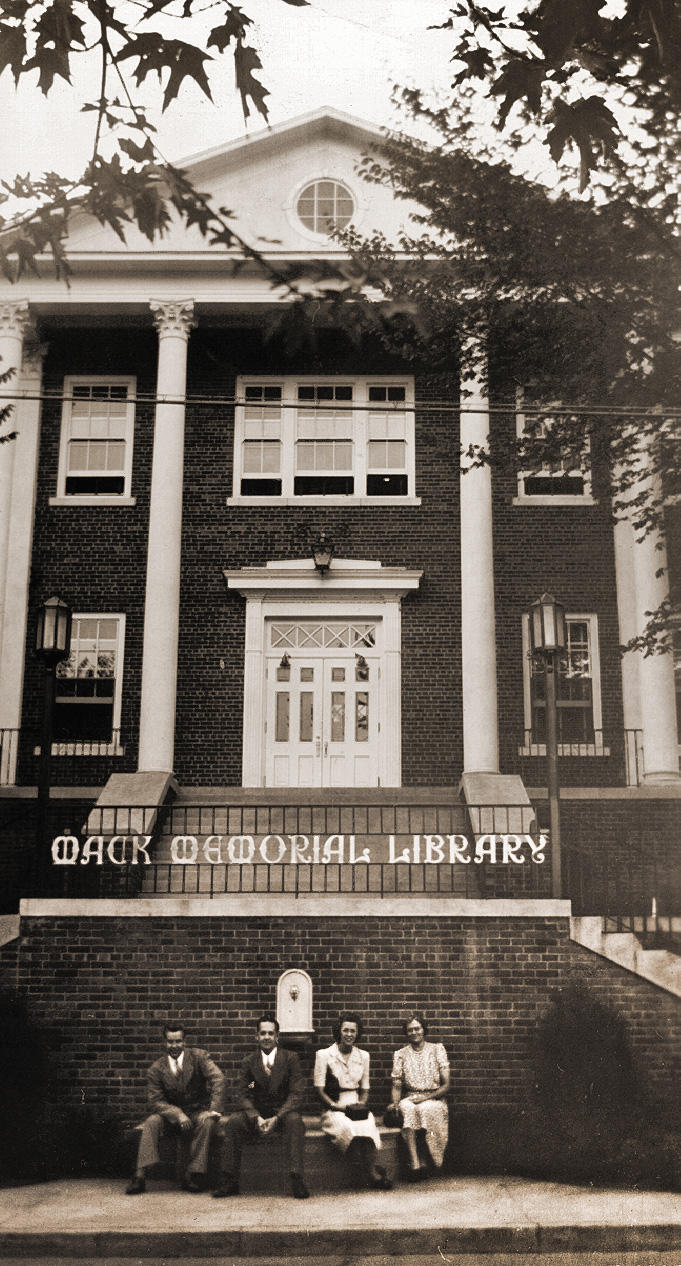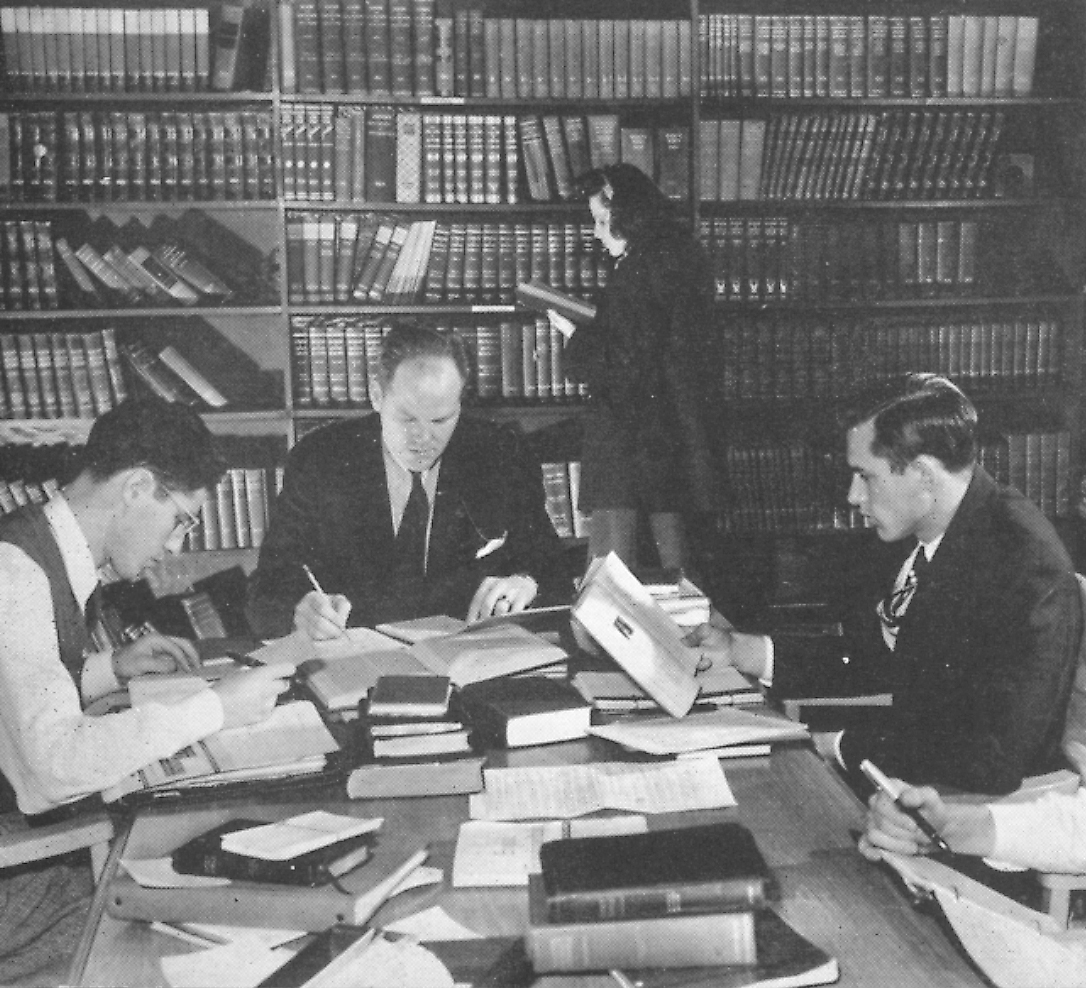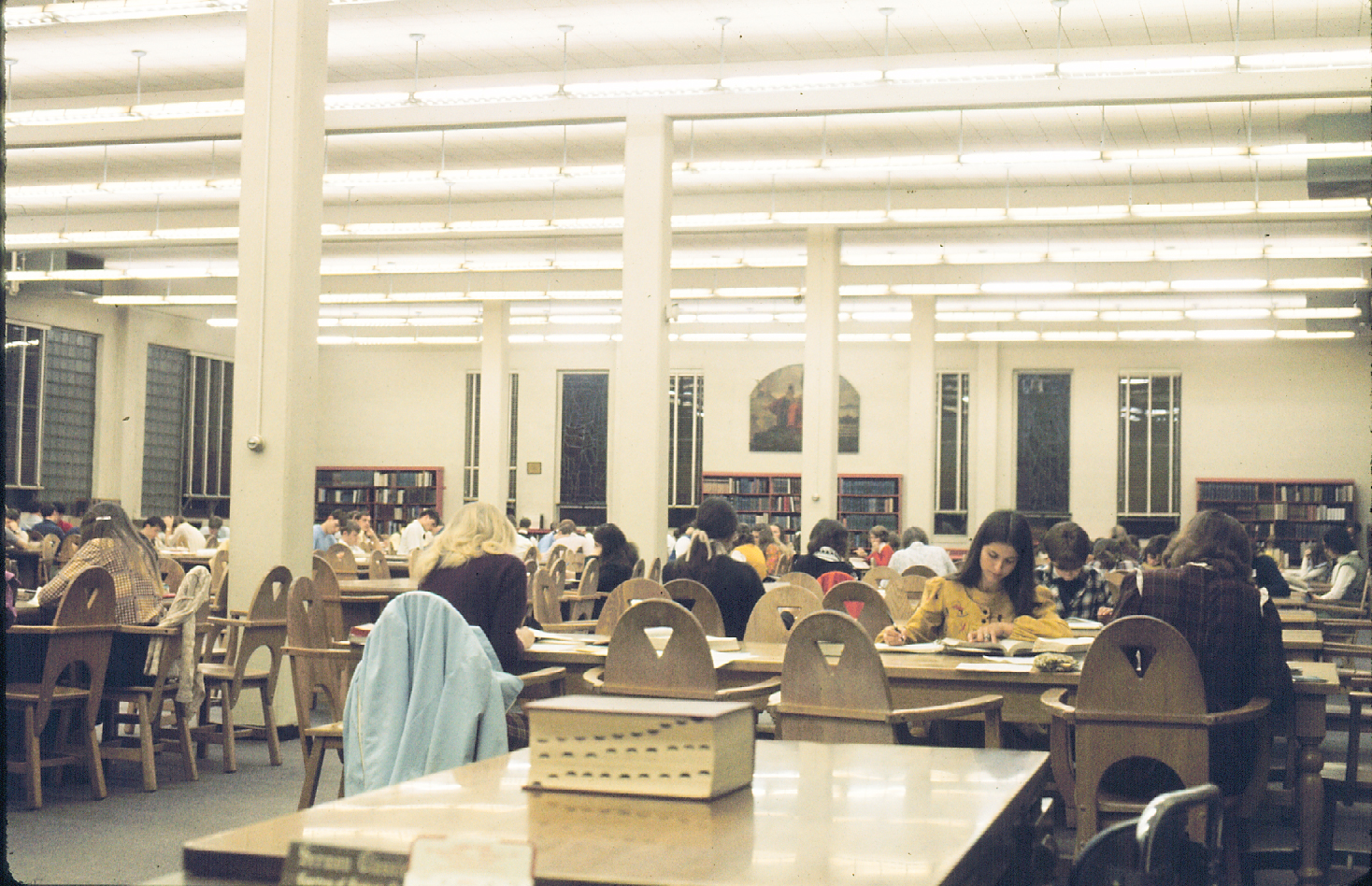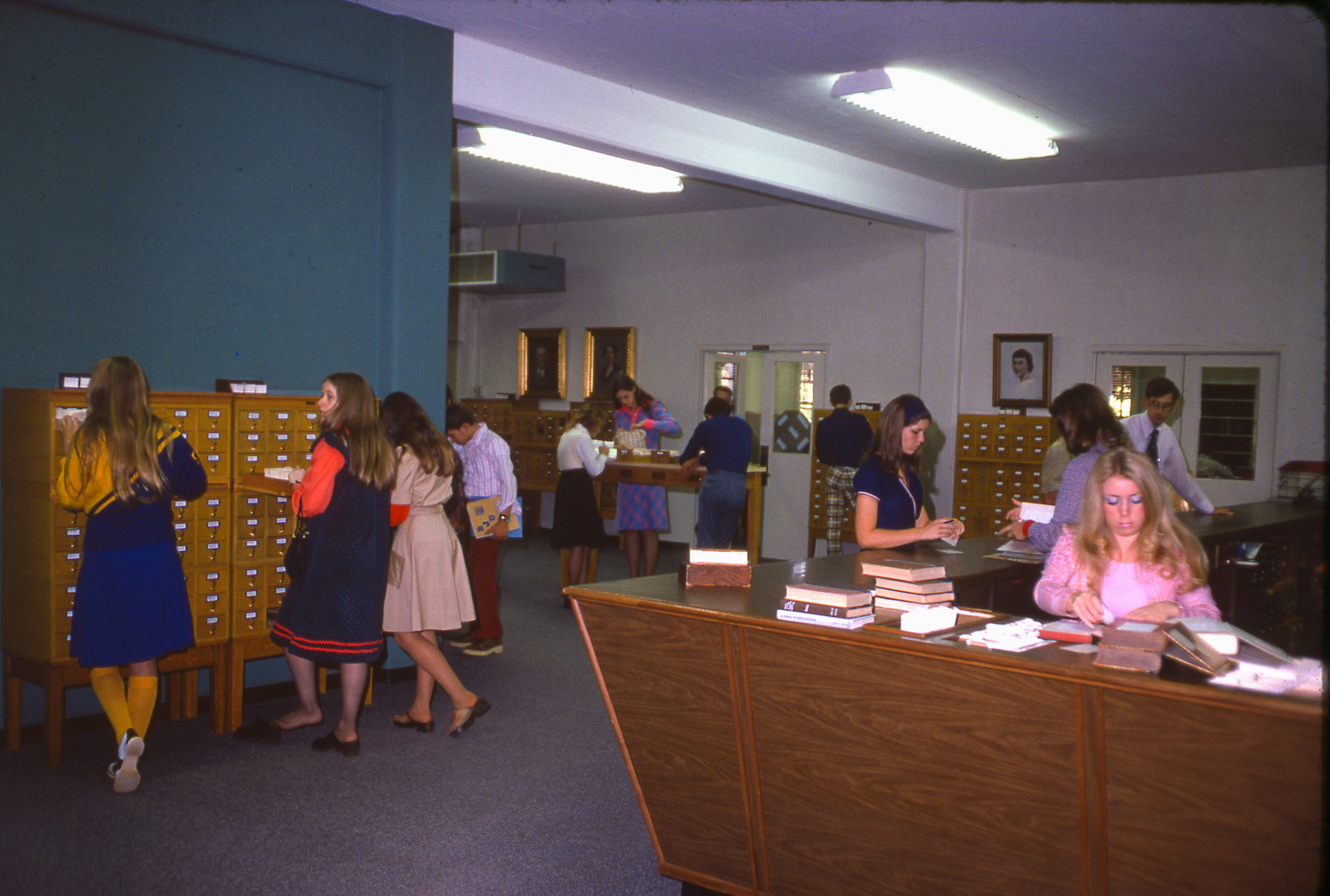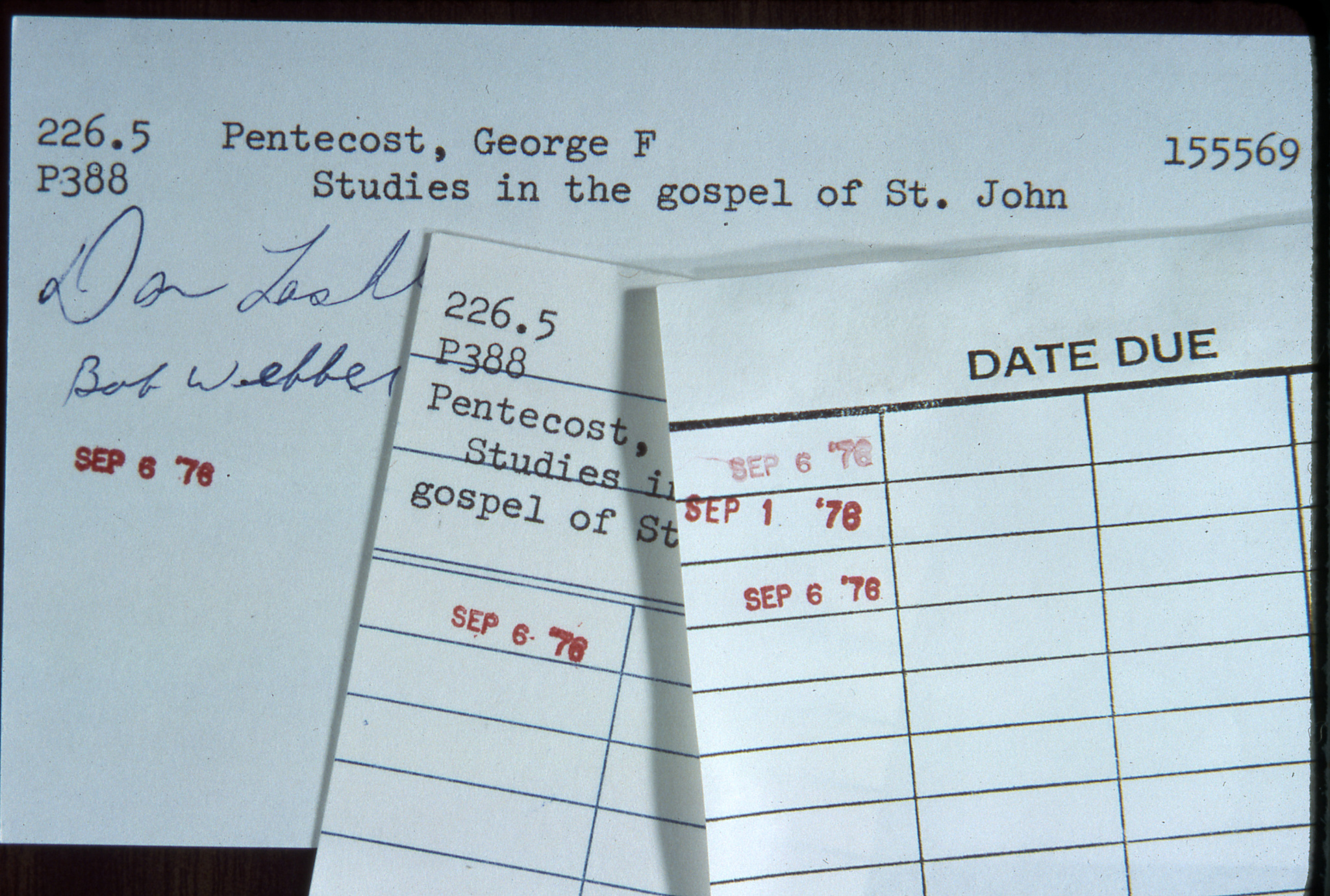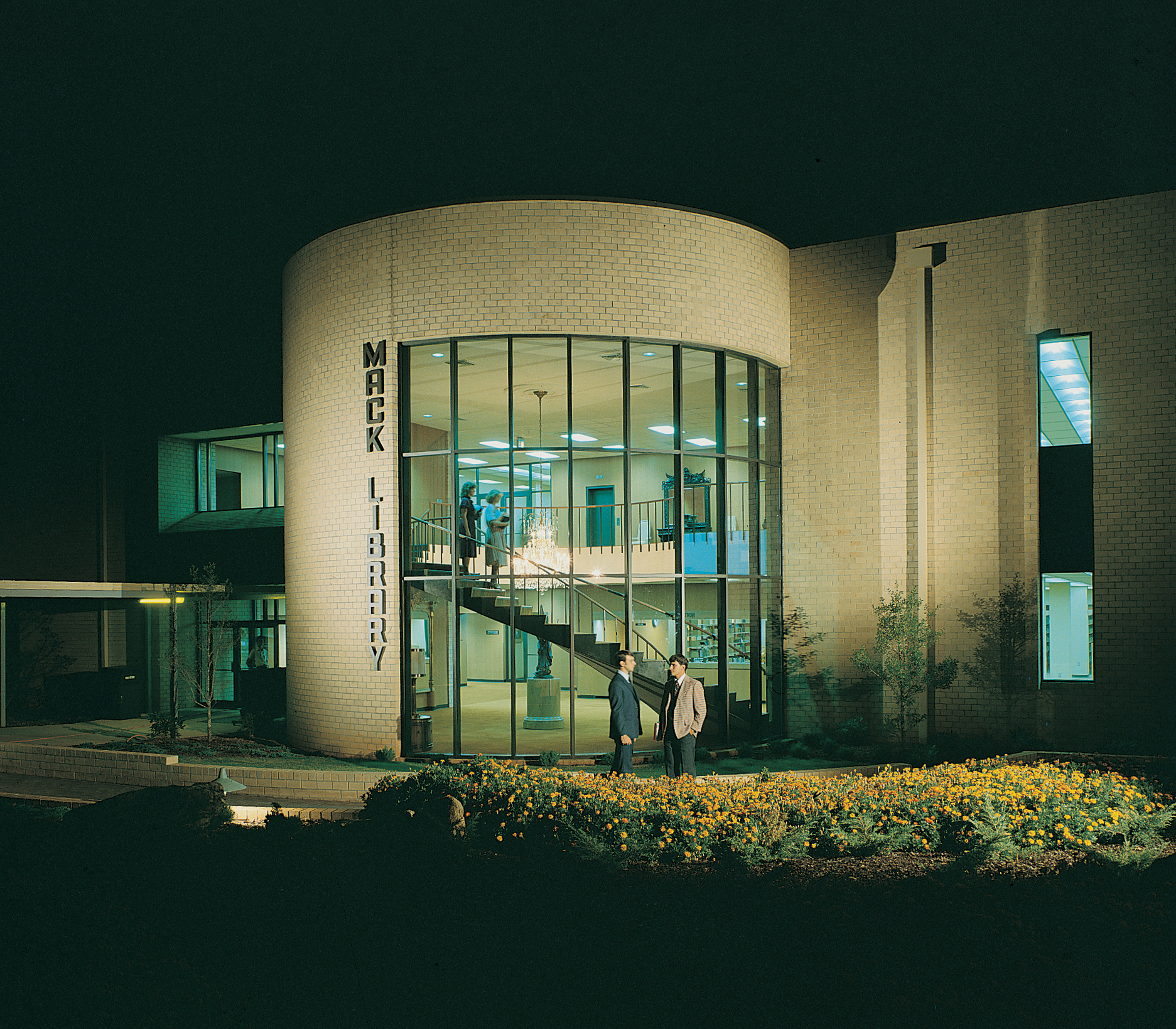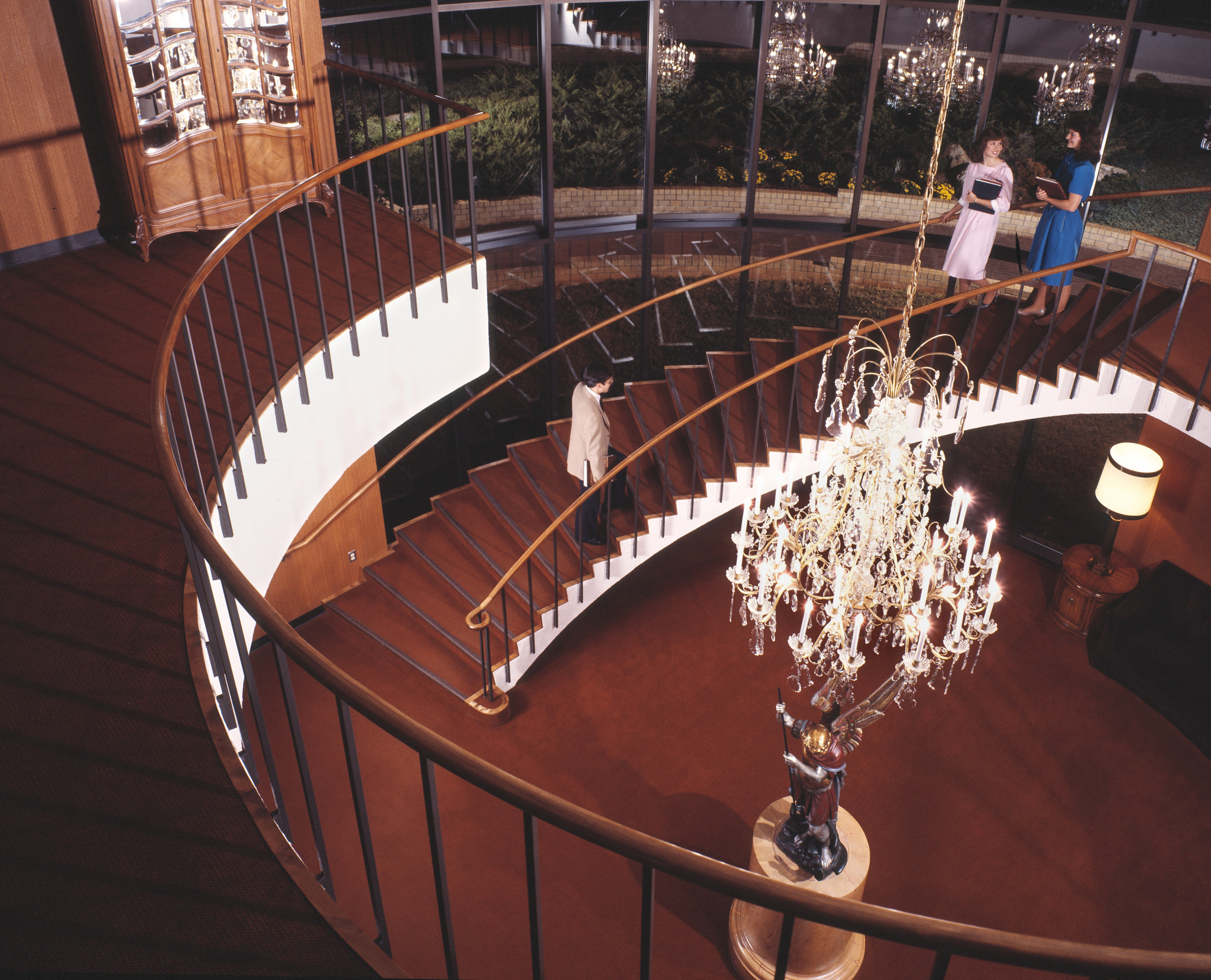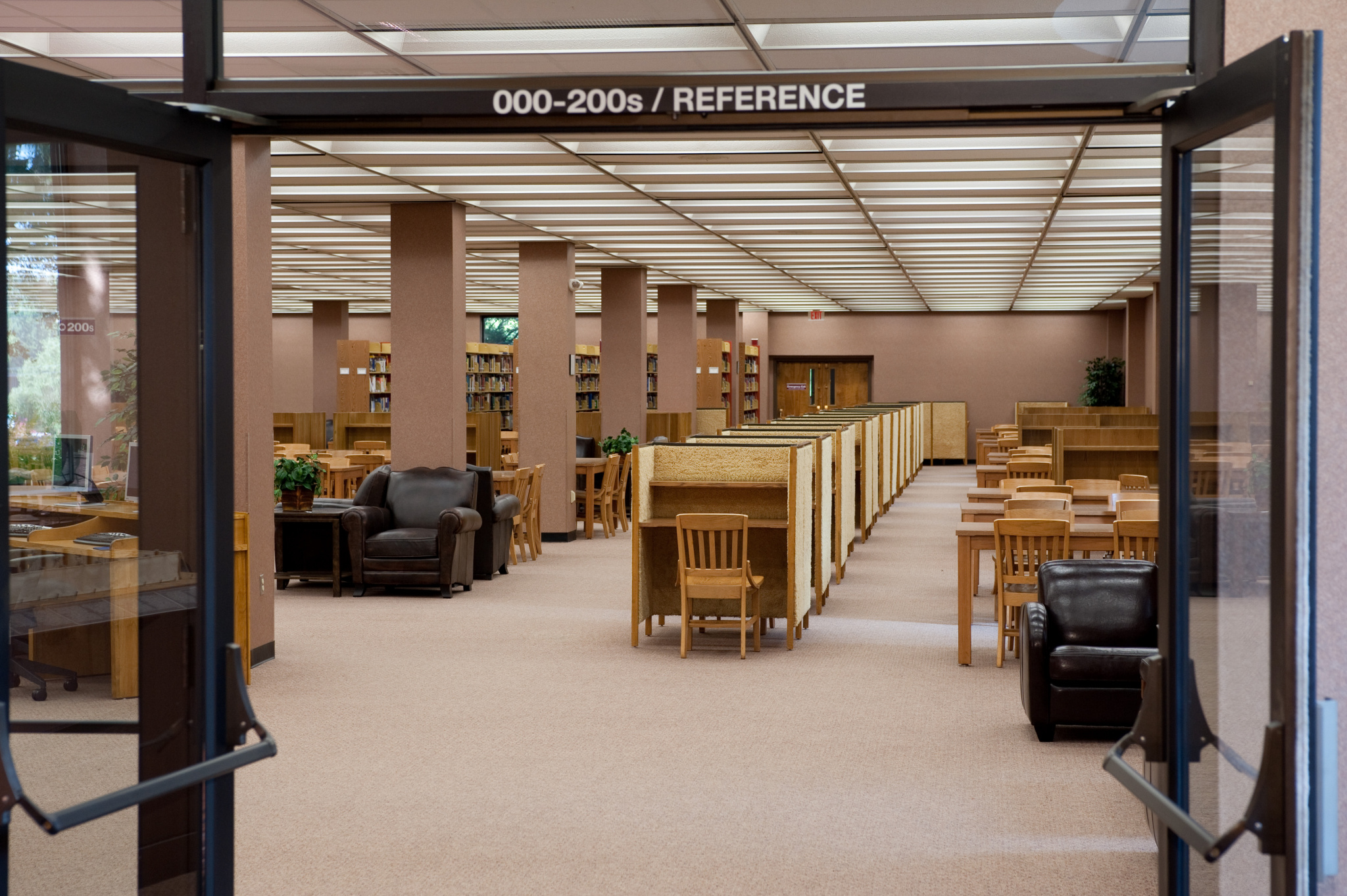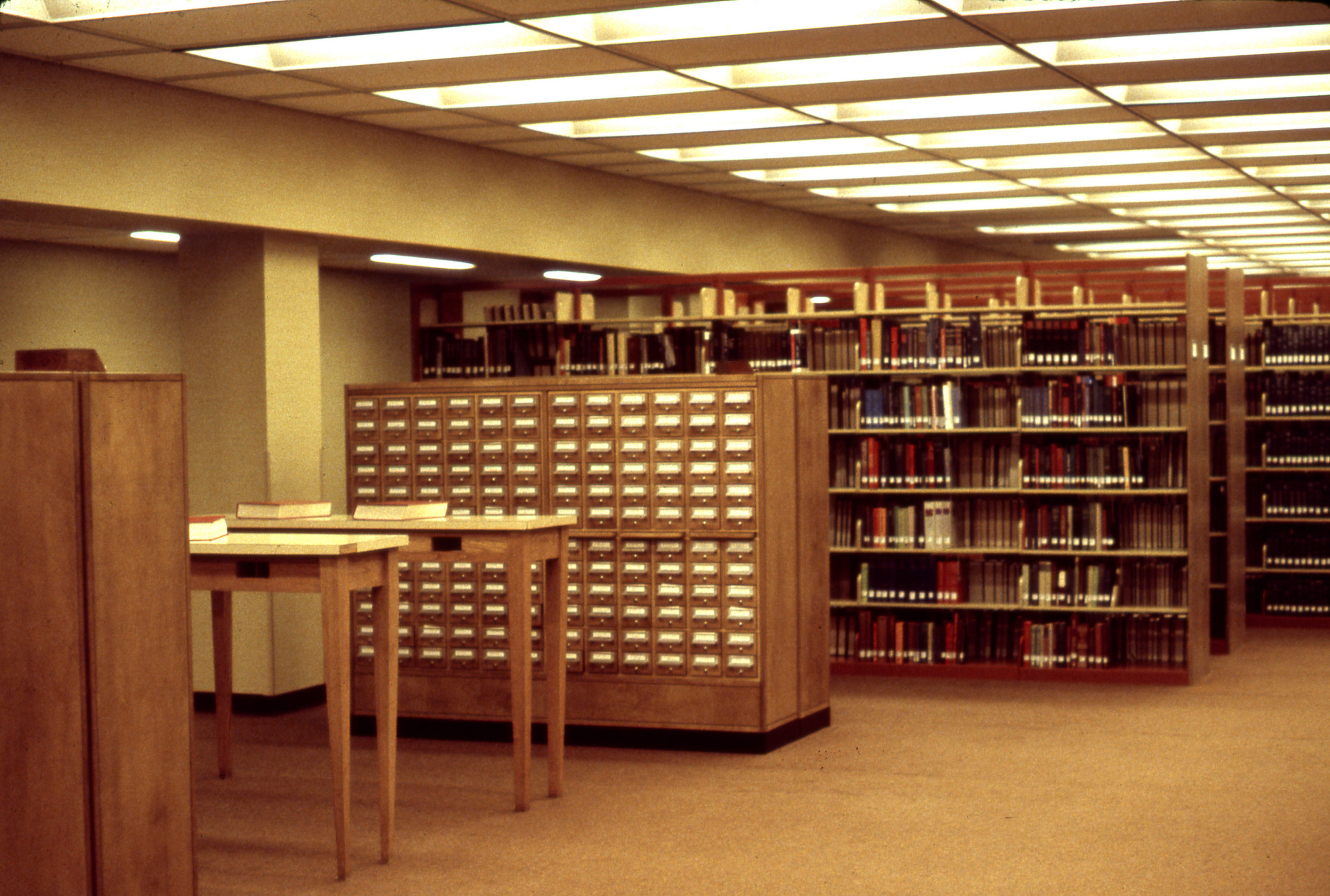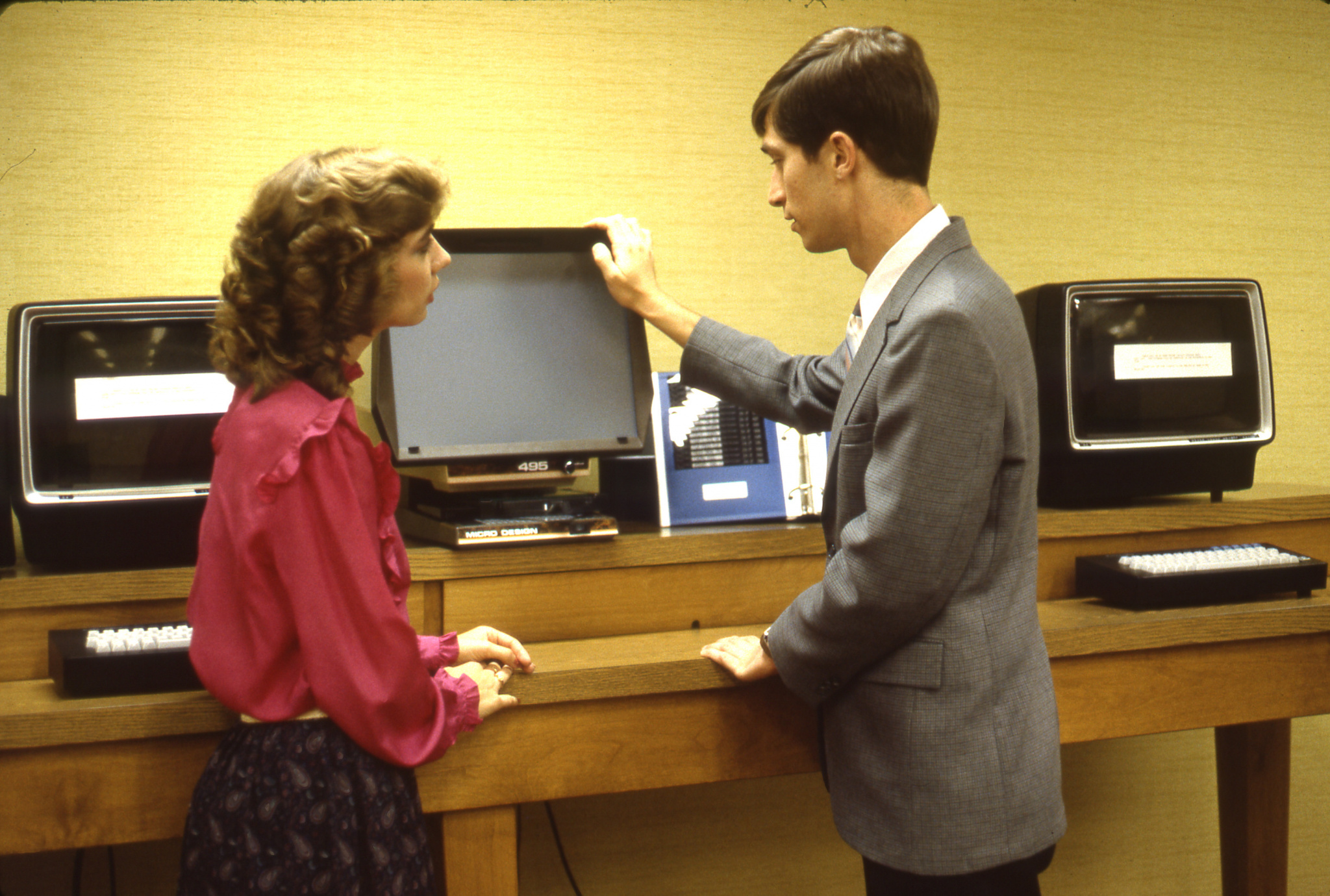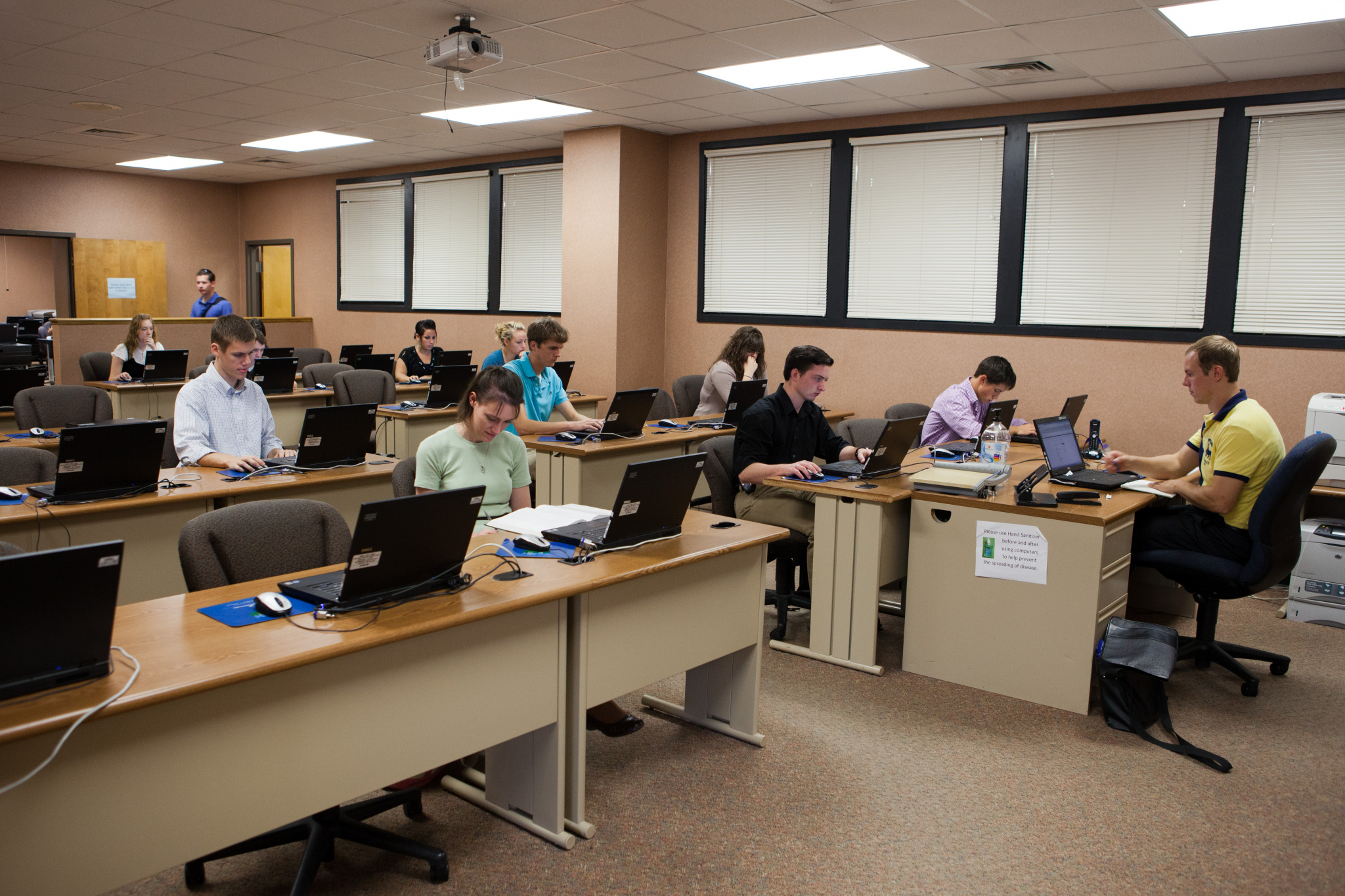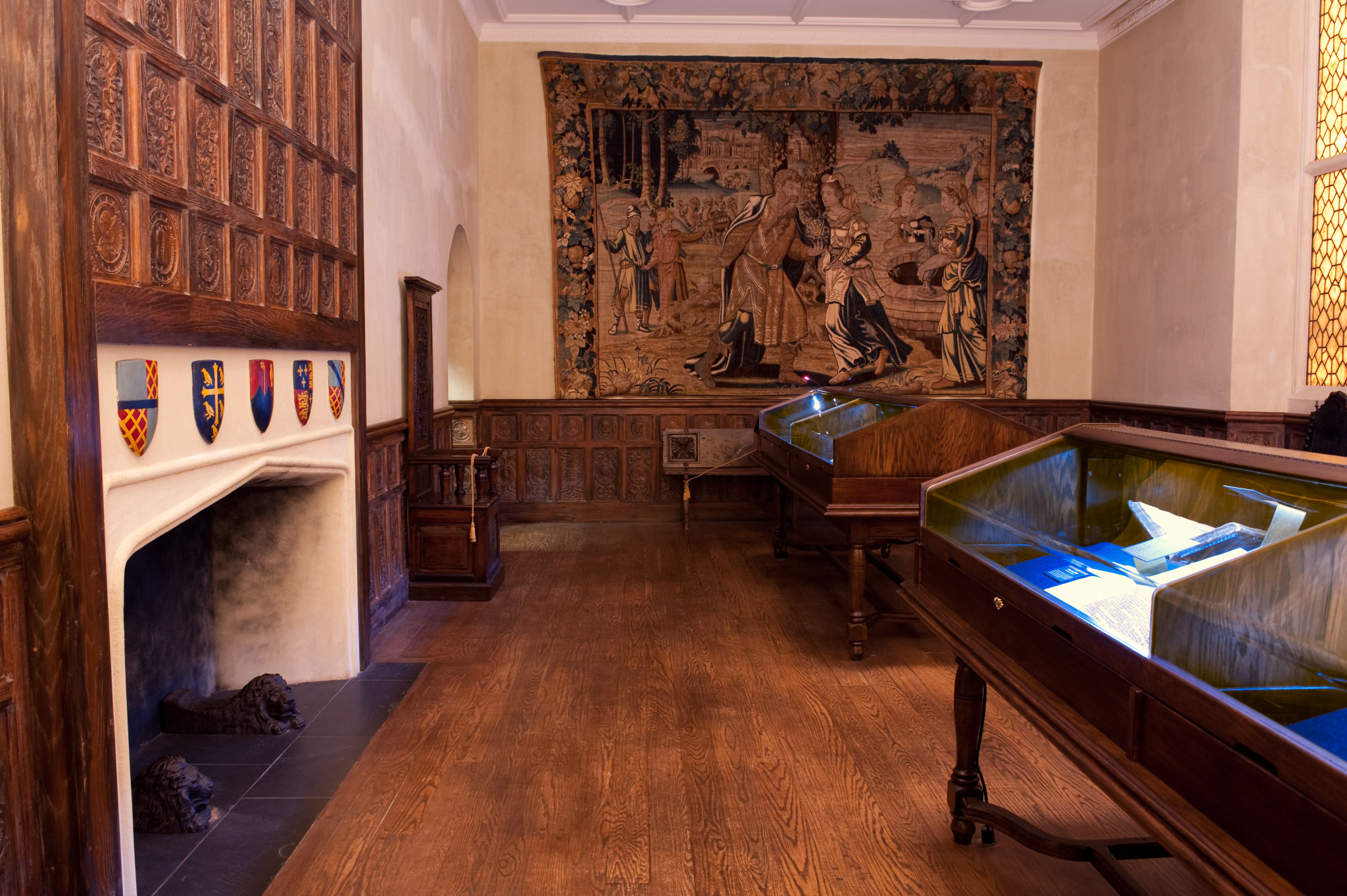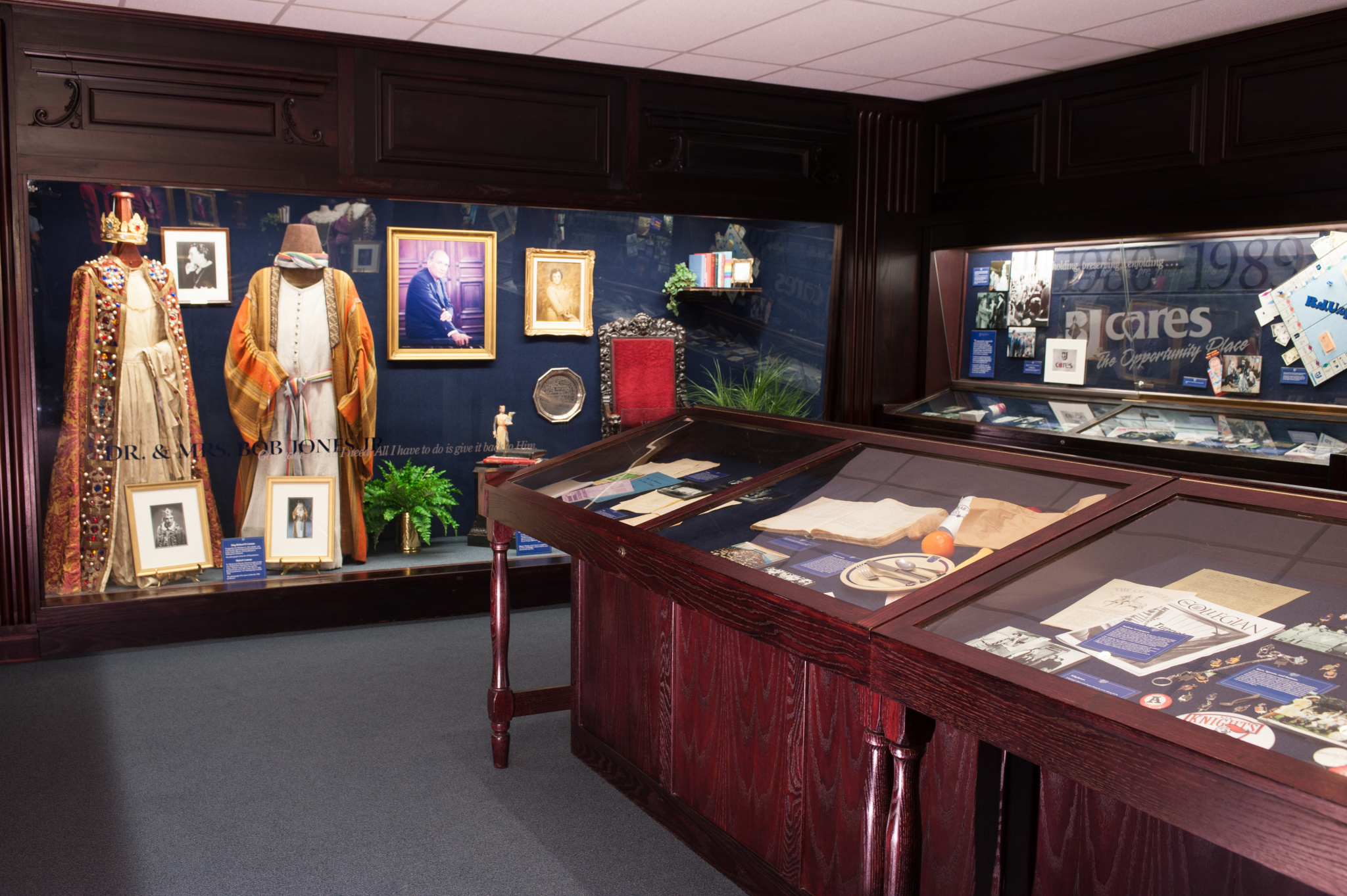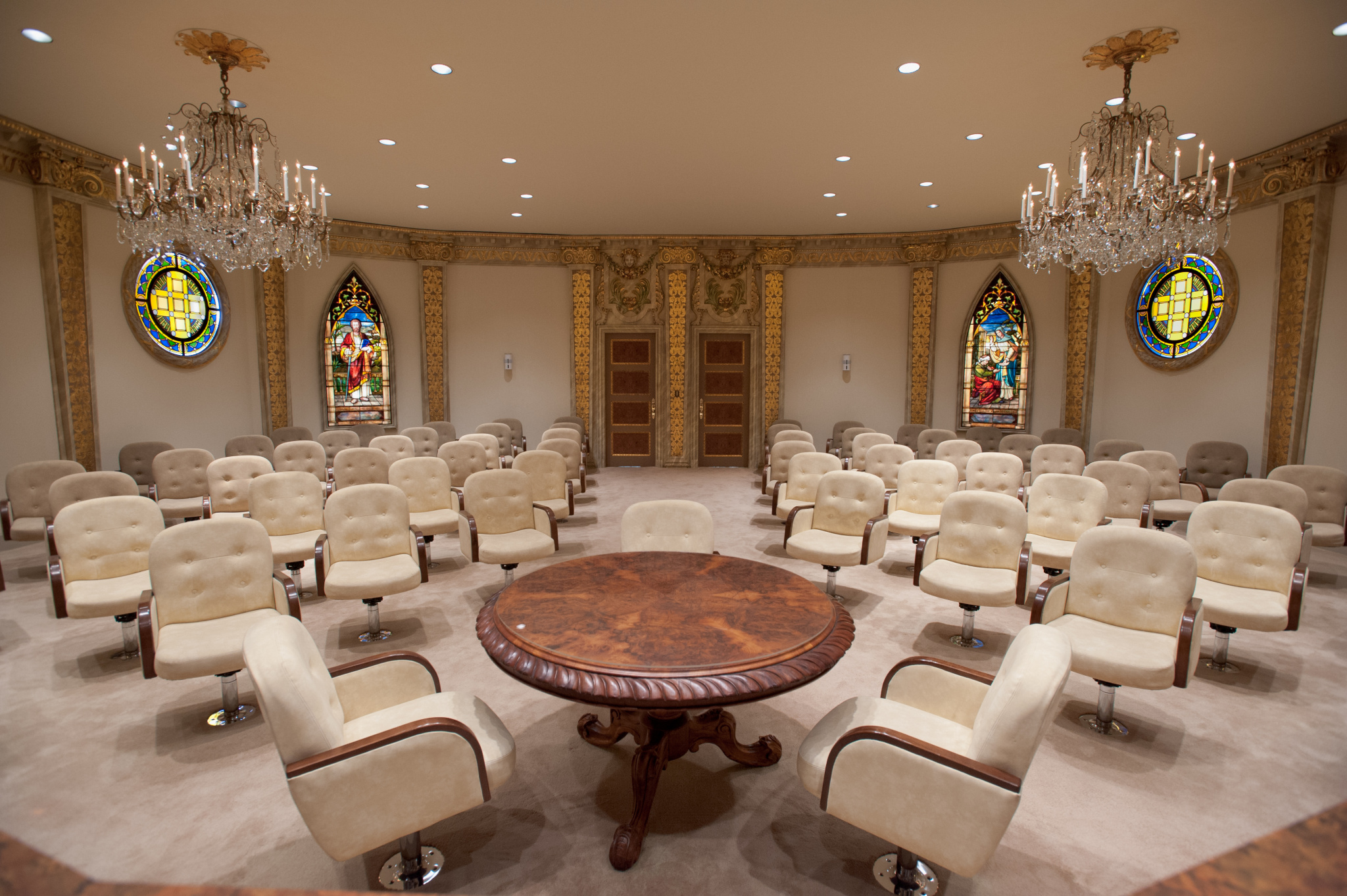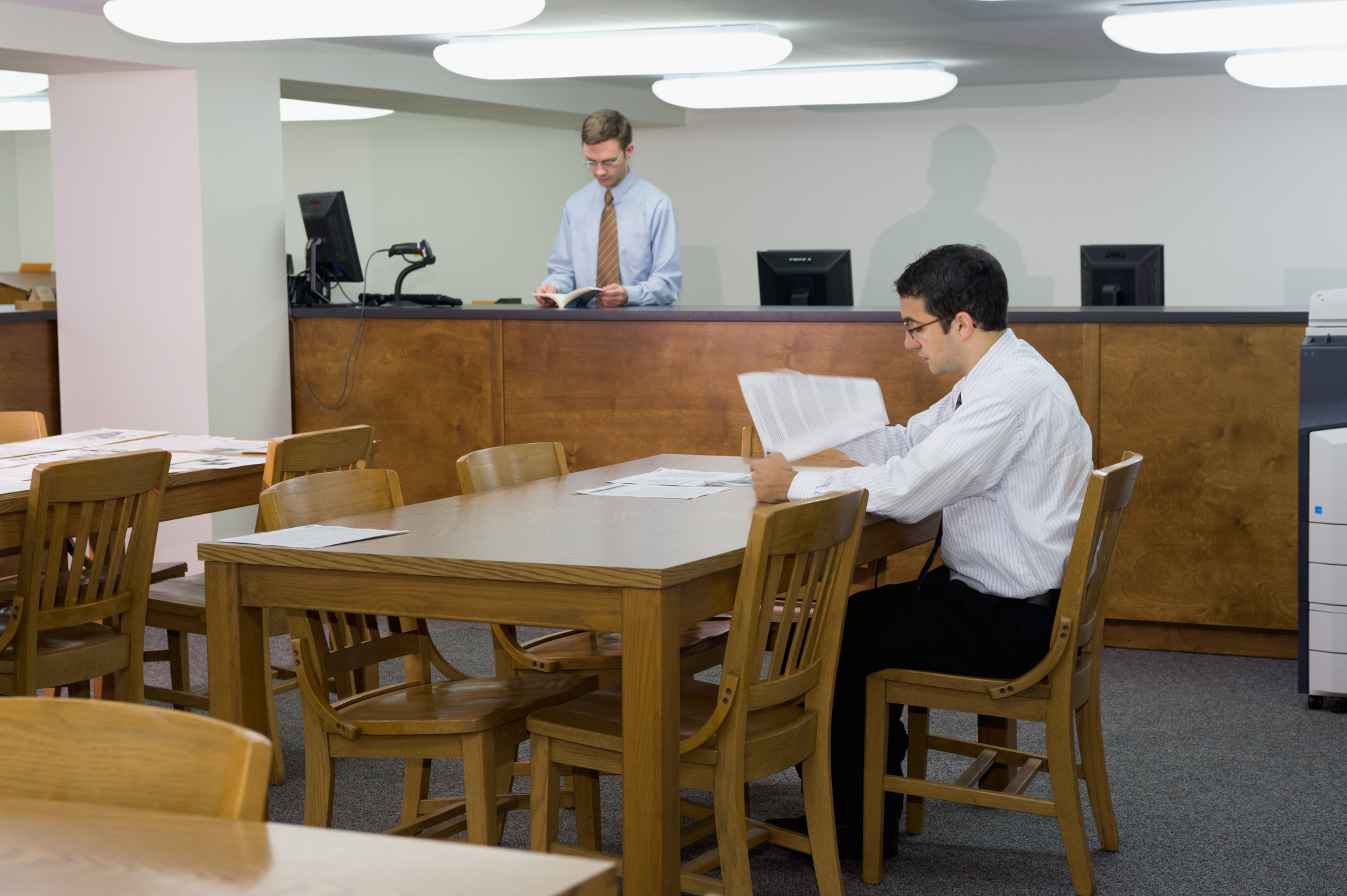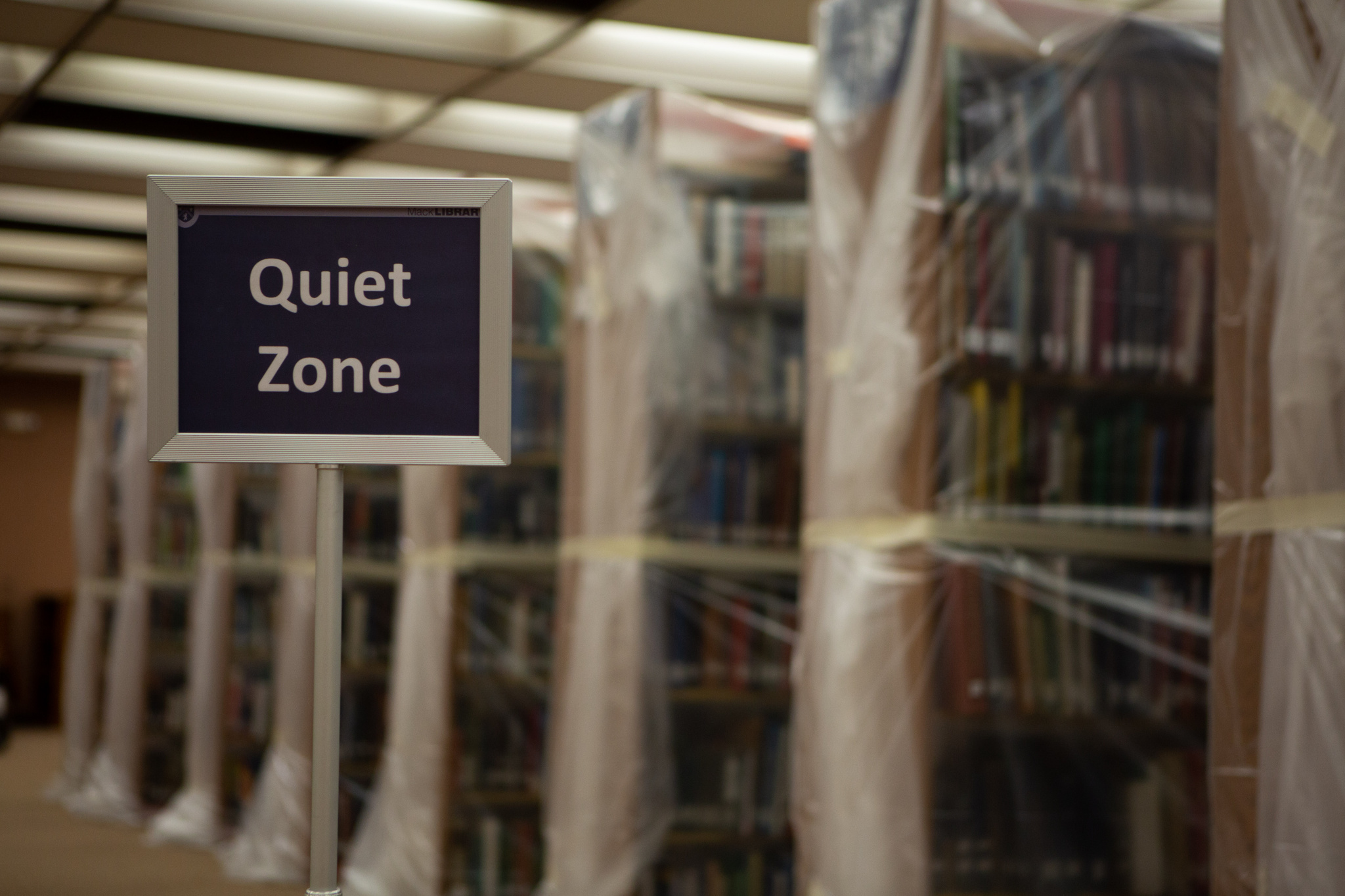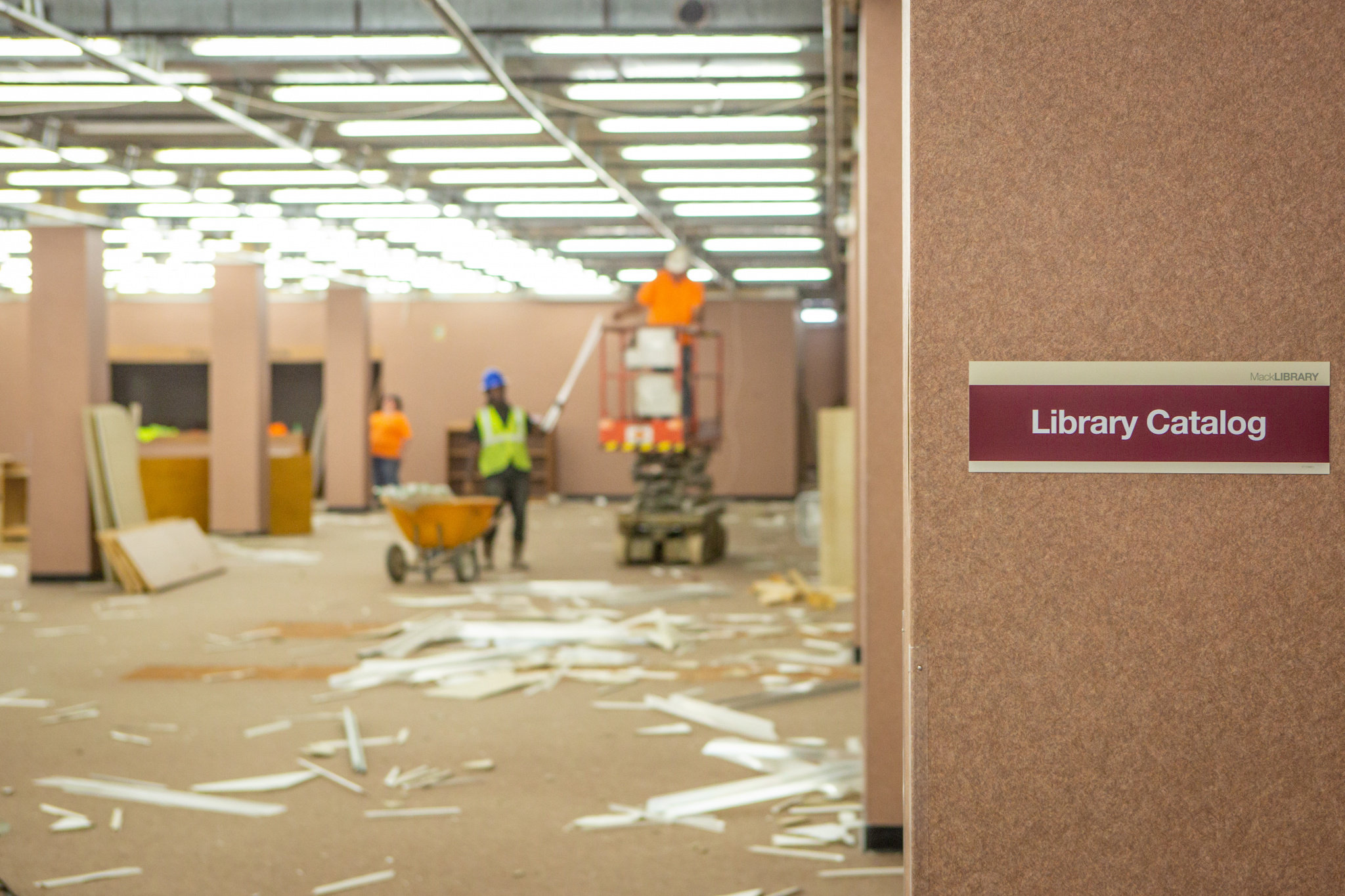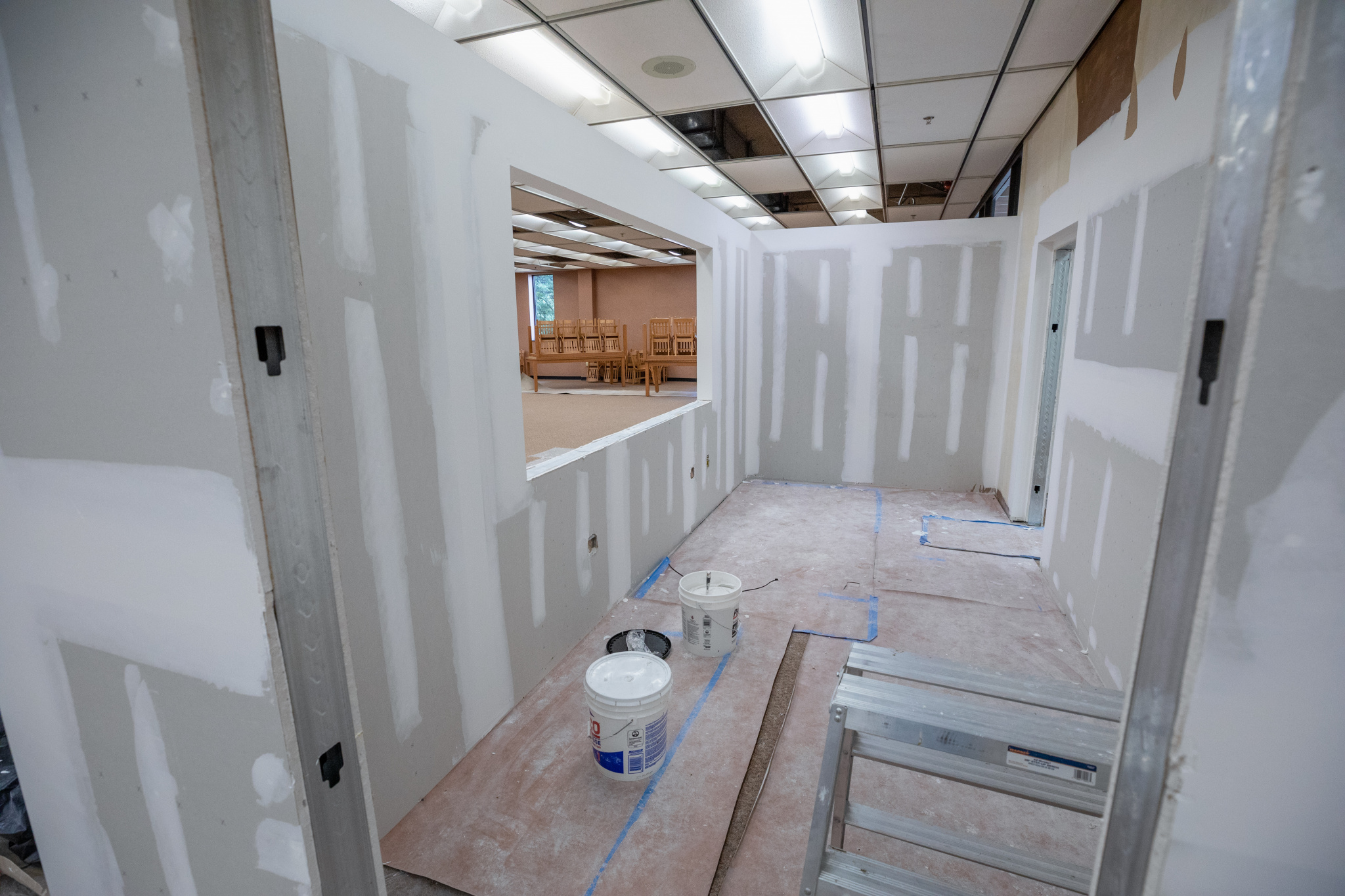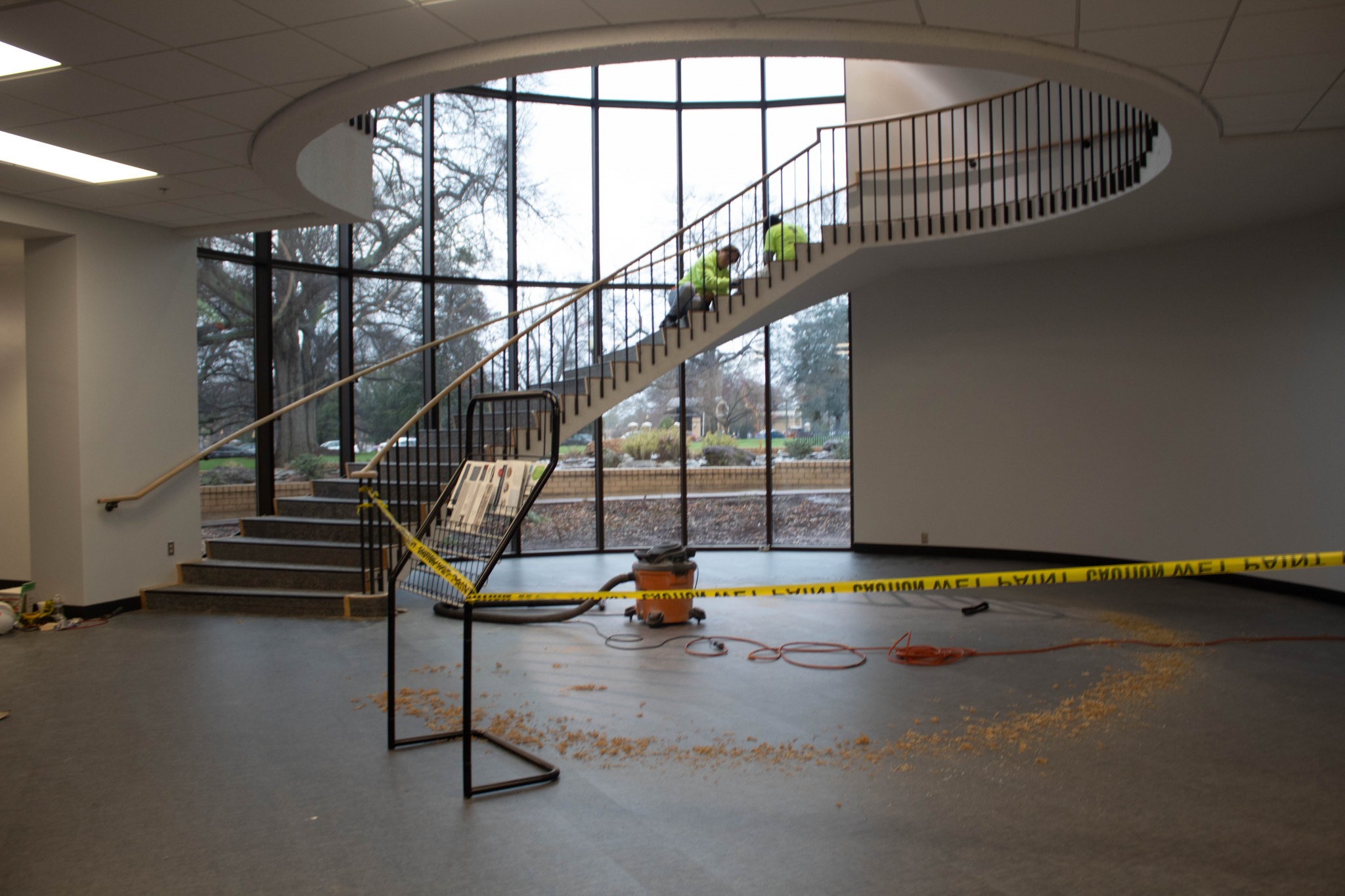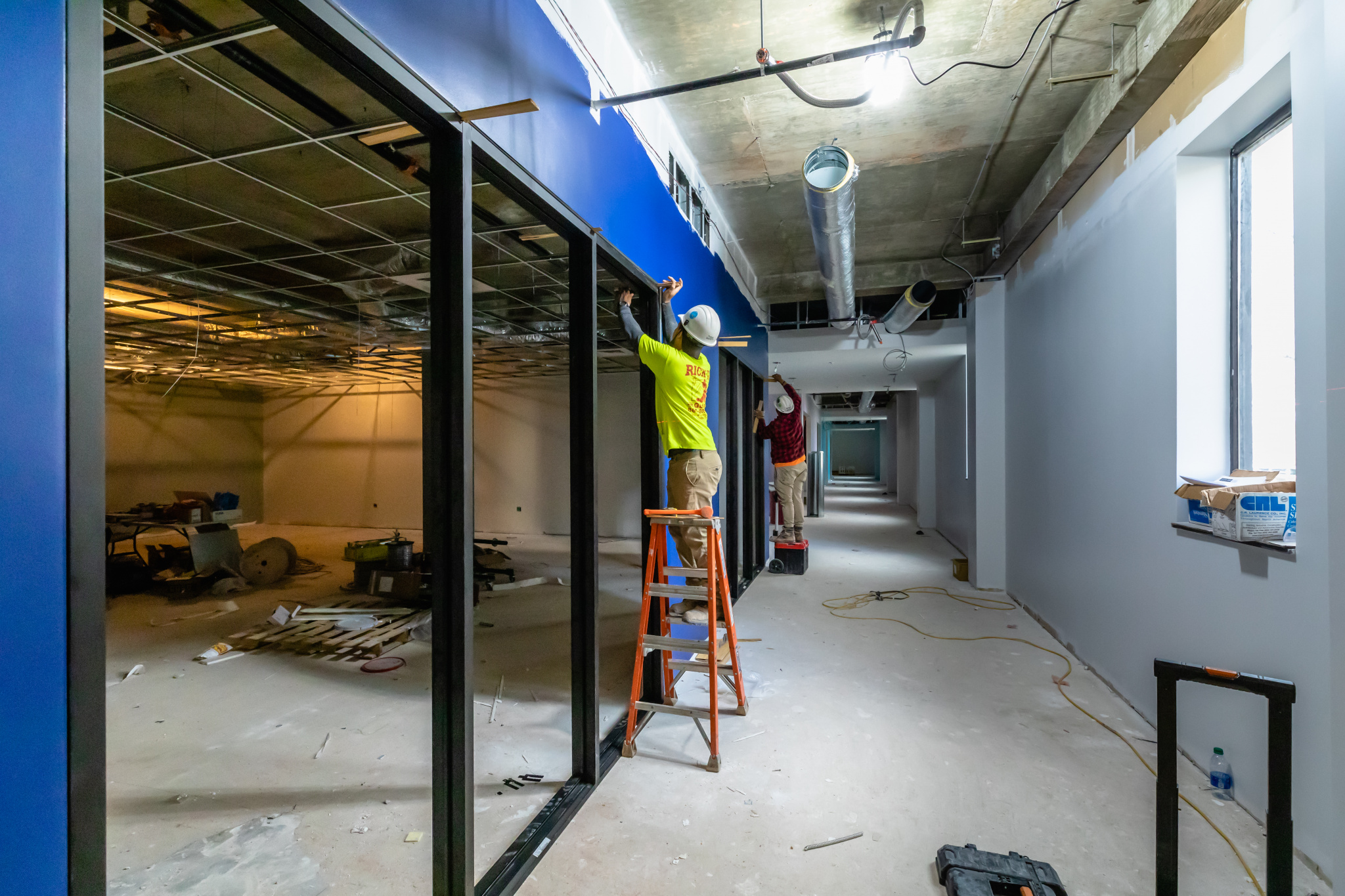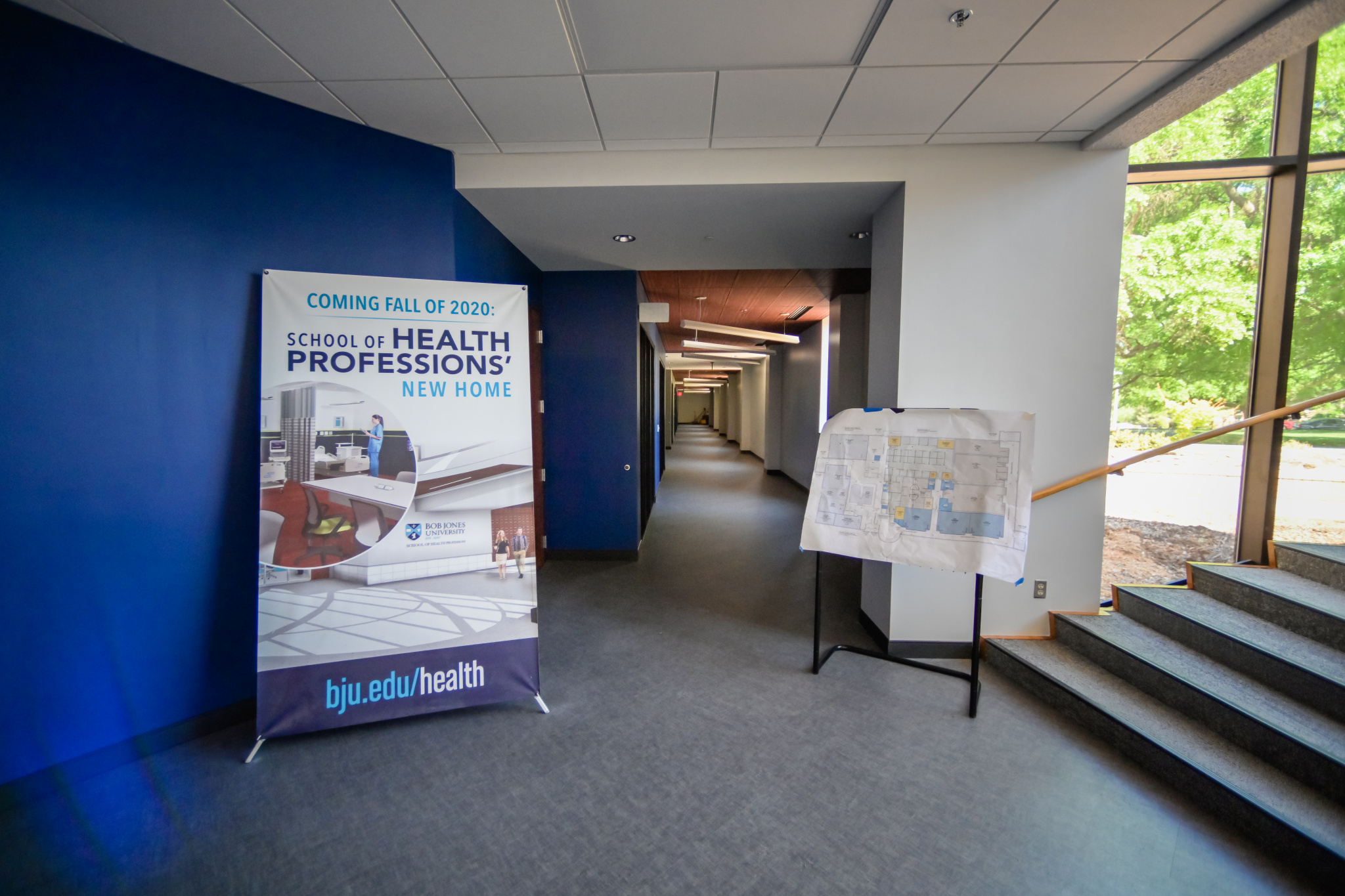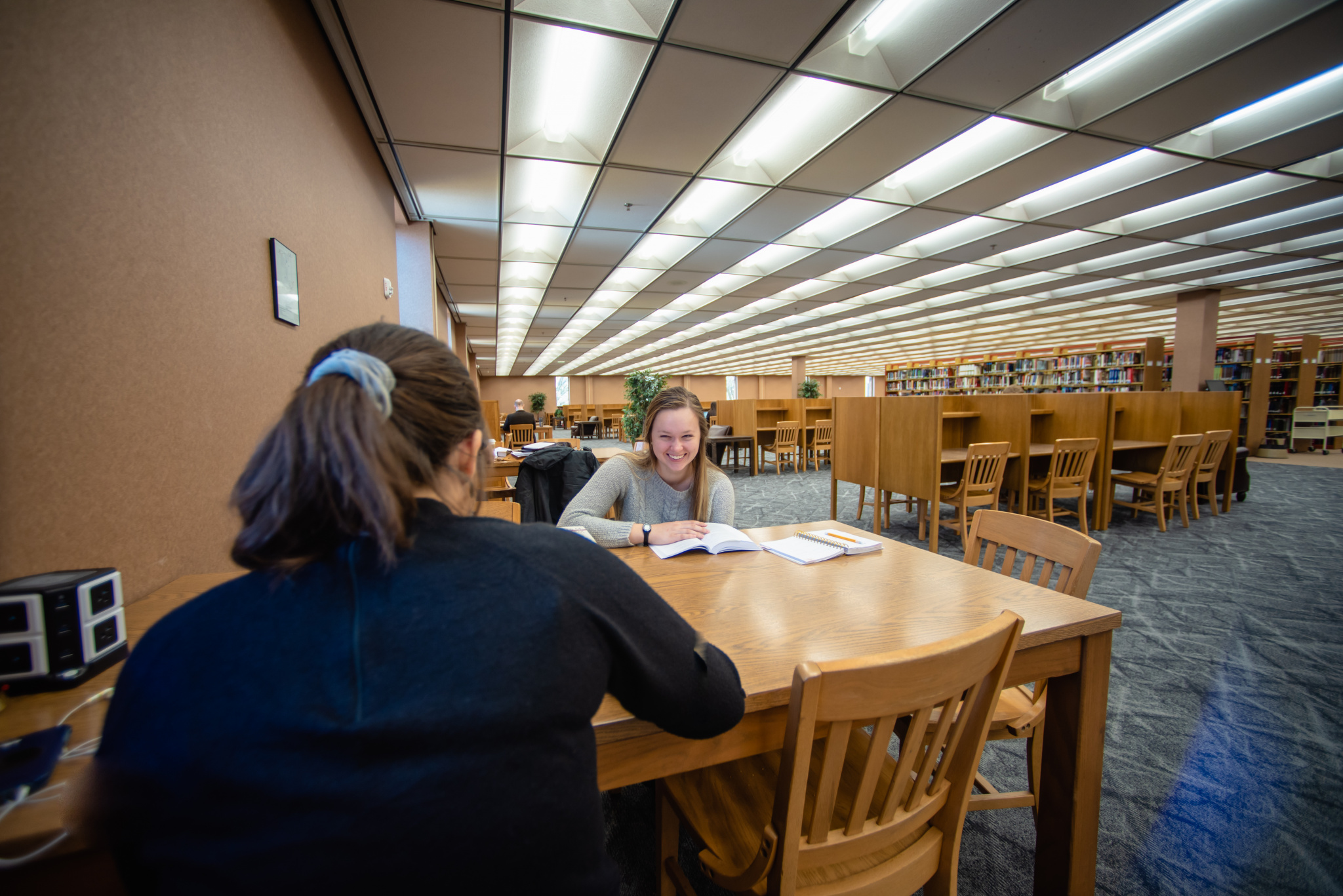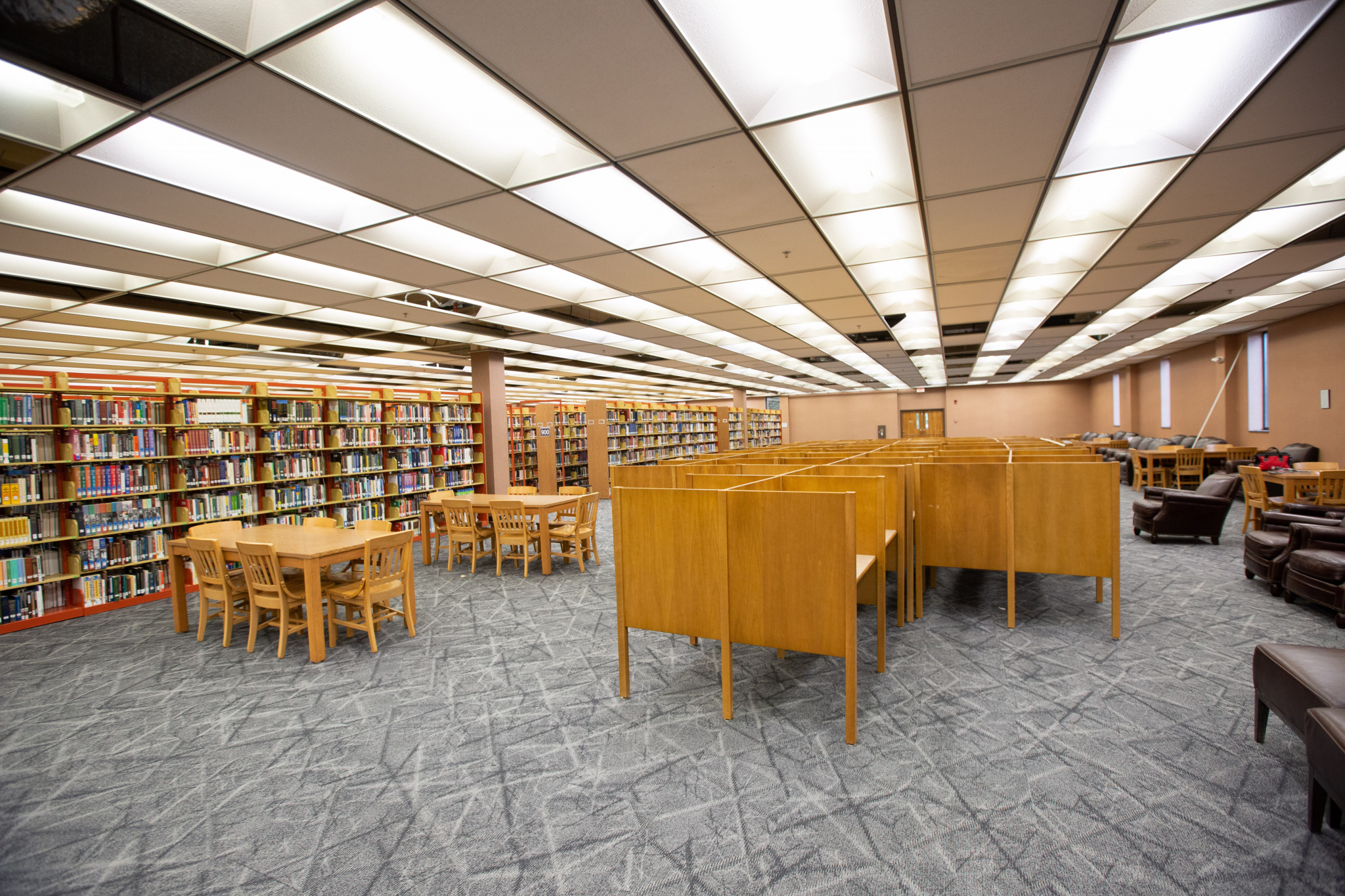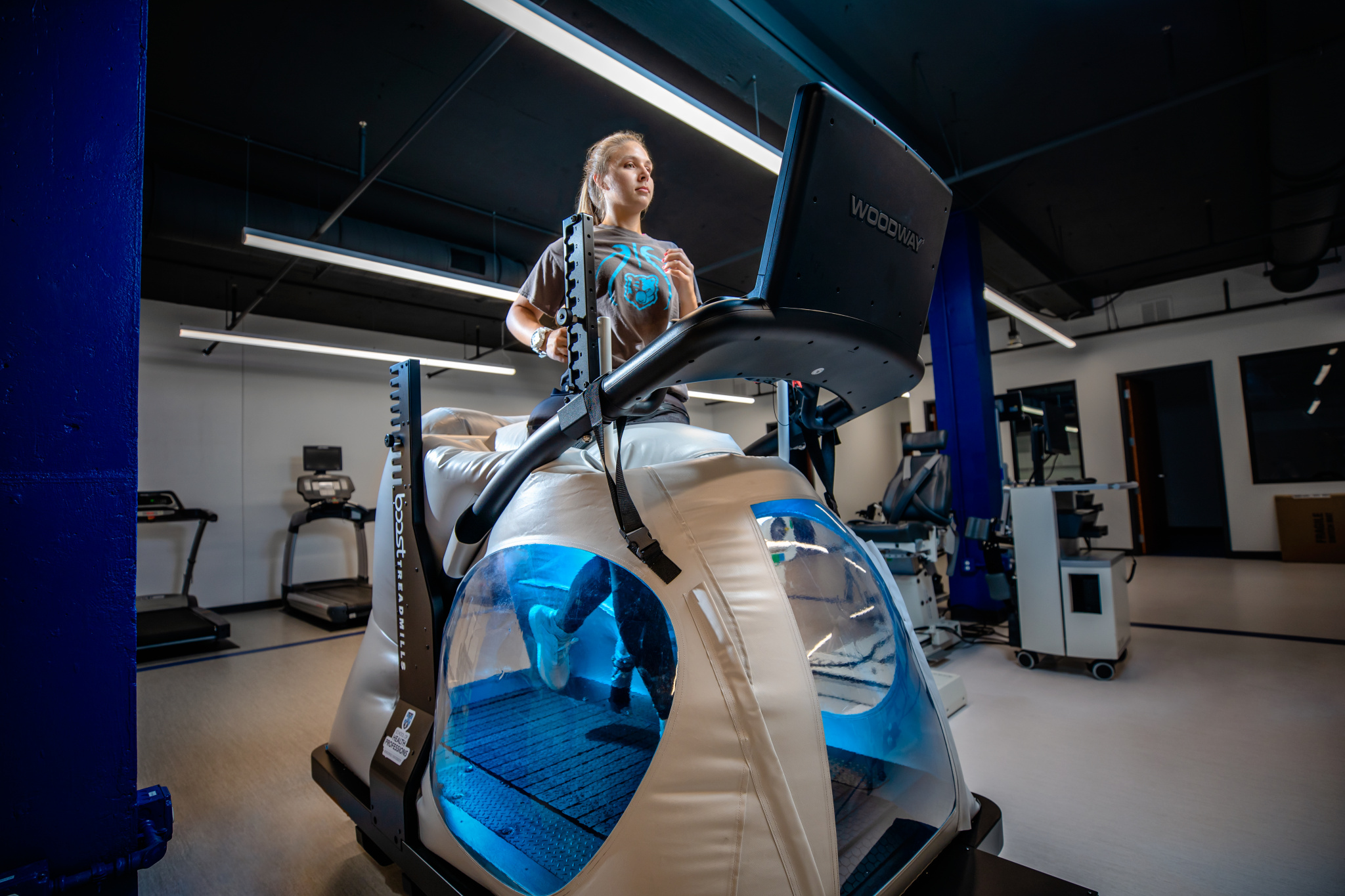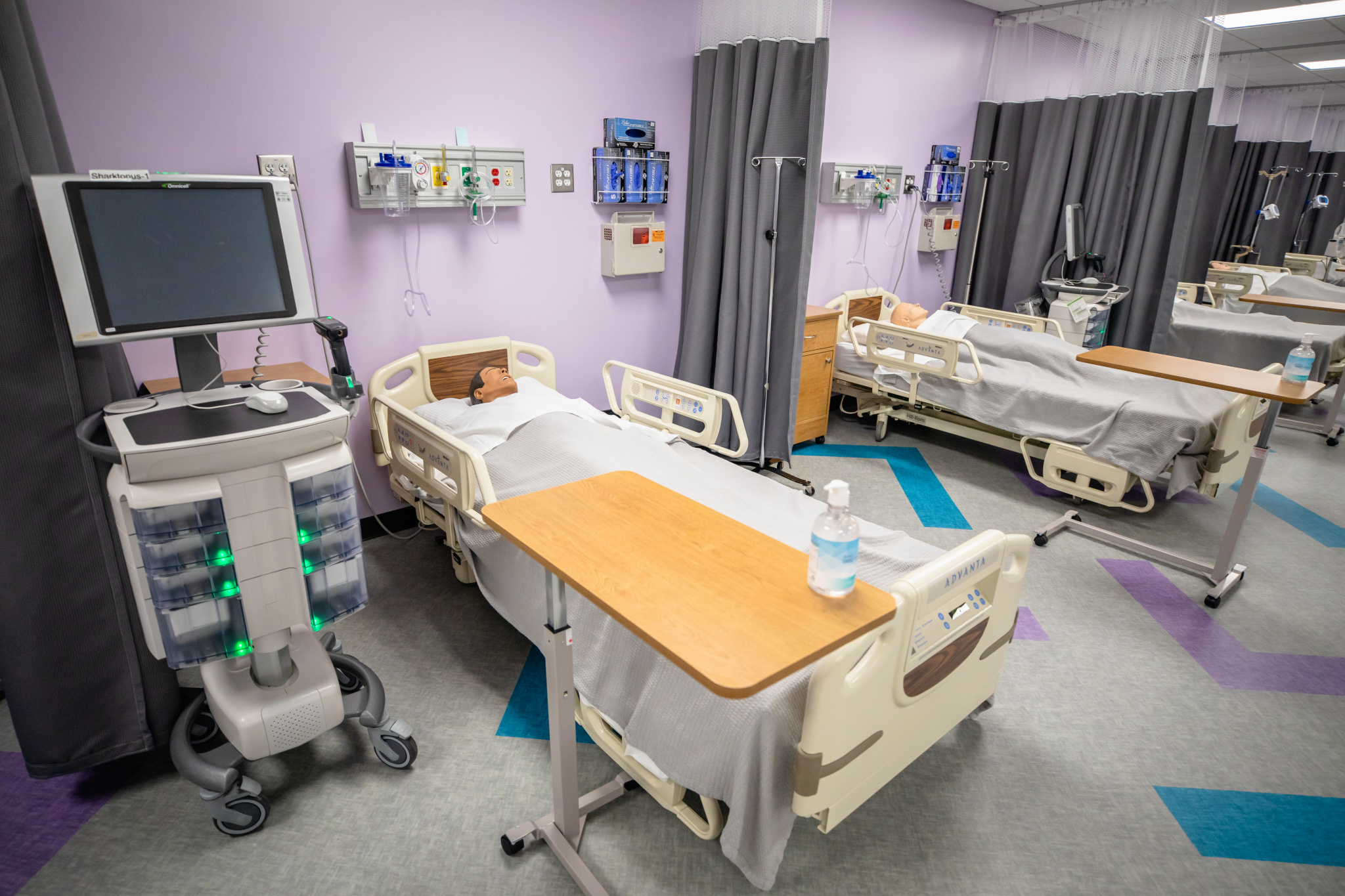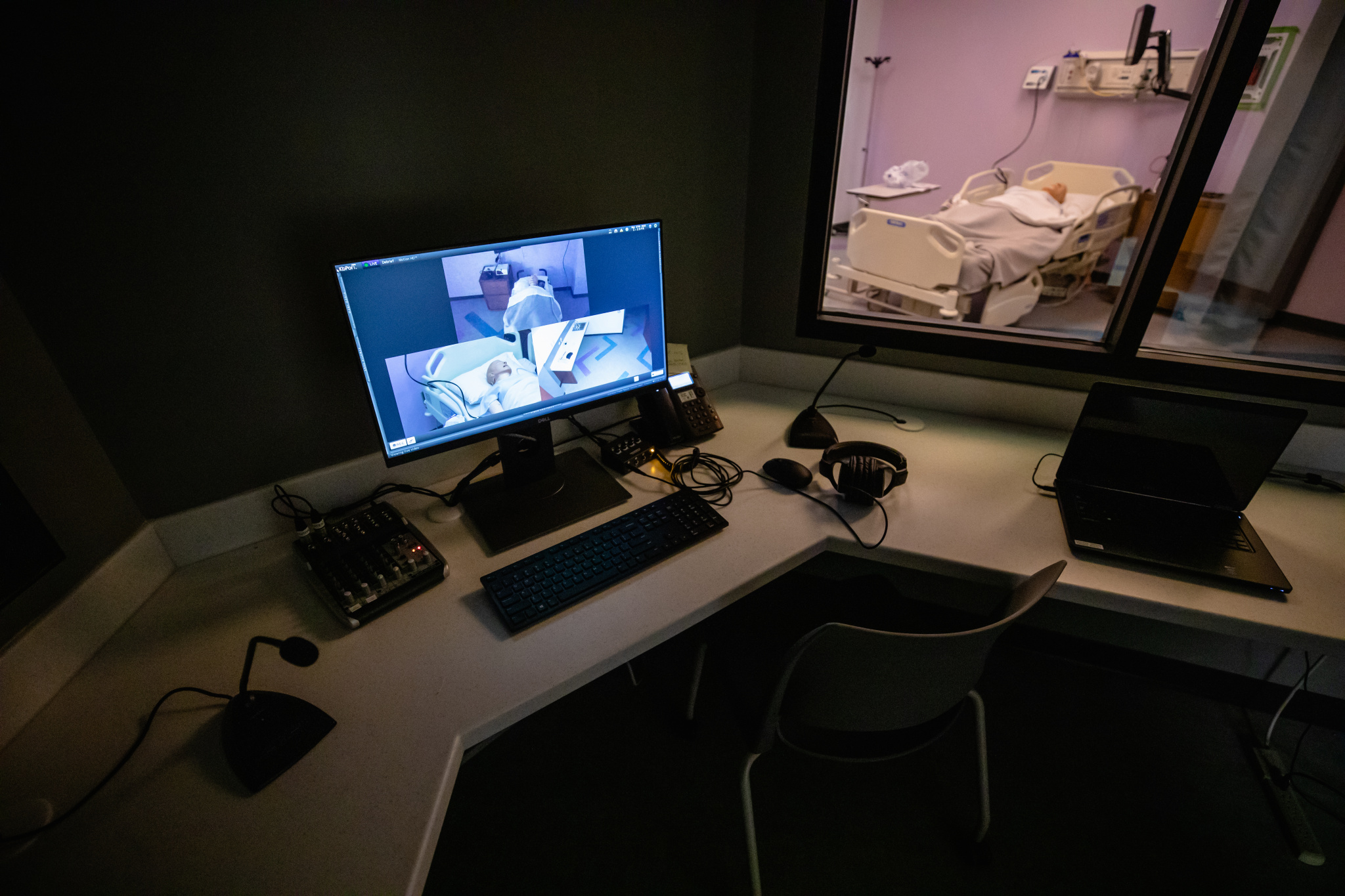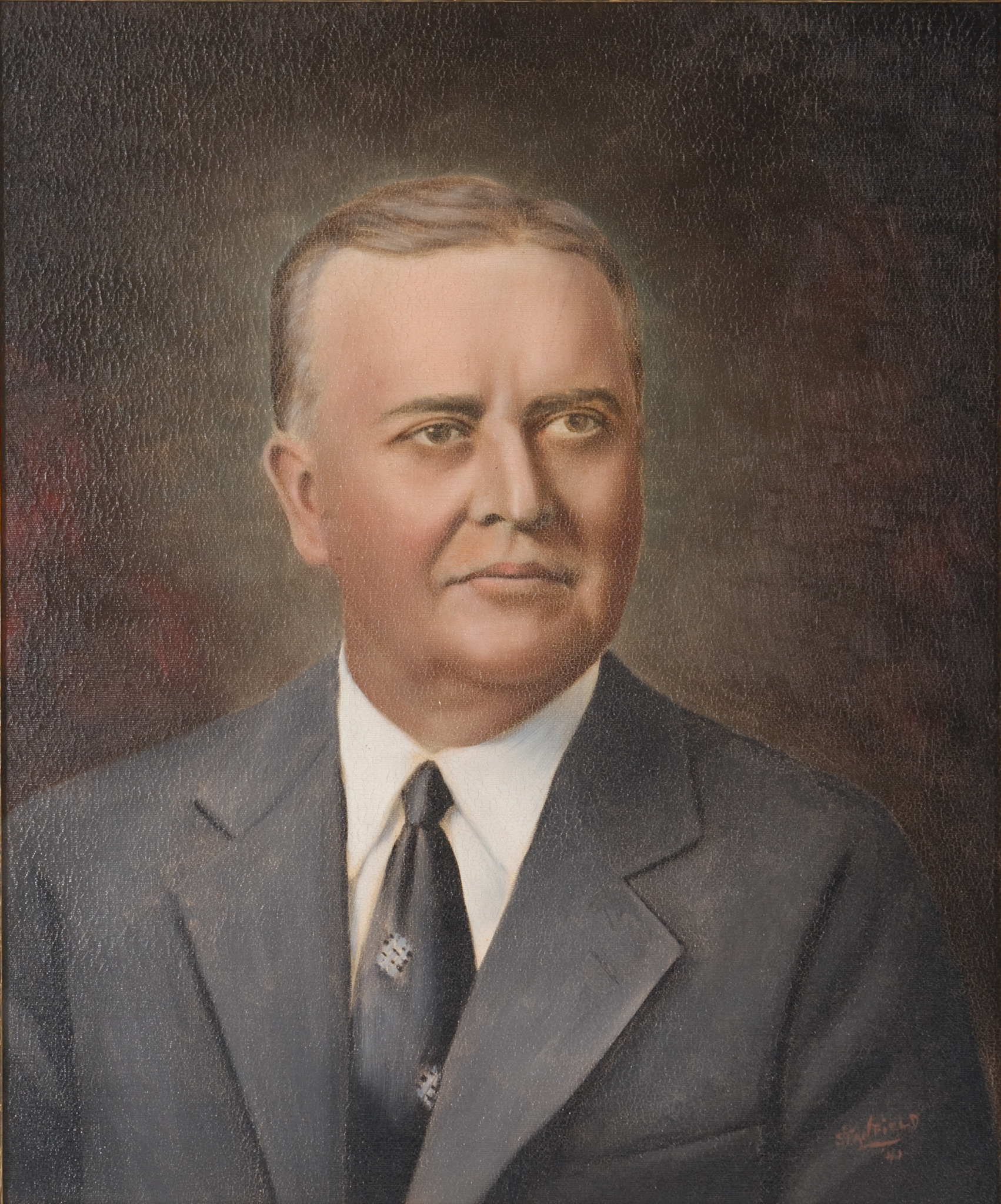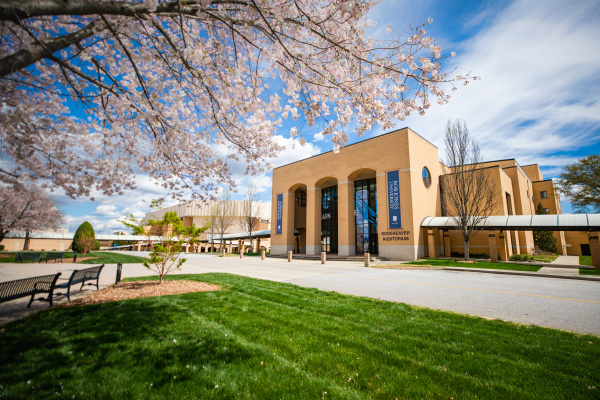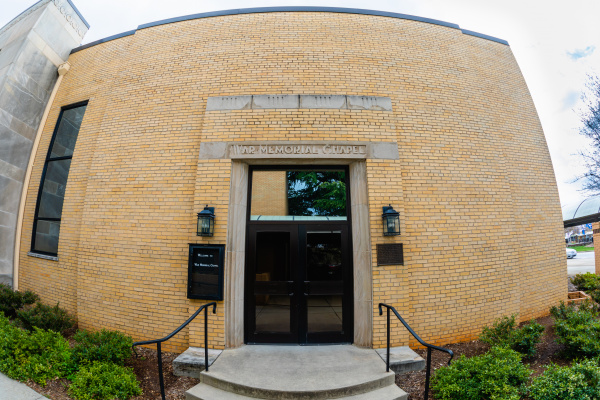Before the digital age increased accessibility to academic resources, a brick-and-mortar library was a key asset to colleges and universities. Even in its early days in Florida, Bob Jones College had a library. However, being housed in the same one-floor building as classrooms, administration offices and a laboratory, it was not very large — only 3,200 volumes. When the College moved to Tennessee in 1933, the library also shared a building, this time the three-story “Old Main.”
In 1936, Dr. Bob Jones announced his intention to build a library by the fall for the growing school. However, because other buildings such as an auditorium and a dining common were urgently needed, construction on the library did not begin until 1940. The completed building was dedicated as the John Sephus Mack Memorial Library on June 3, 1941, to honor a friend and financial supporter of the College. Mack had passed away in the fall.
The three-story red brick library had a stack capacity of 50,000 volumes and an open shelf capacity of 25,000. The main reading room held up to 148 people. The library also housed offices for the business manager, publicity director, dean, president, acting president and high school principal in addition to the academic office and the records room.
The New J. S. Mack Library
When the College moved to Greenville in 1947, the new L-shaped J. S. Mack Library was one of the original buildings that greeted students that fall. It featured three reading rooms on the main floor — the reserve room, the reference room and the periodical room — and a large reading room on the second floor for books on art, music and literature. Before the Fine Arts Center was built with a music library in 1956, there was also a separate room for music, speech and language records. (Once the new music library was built in 1999, 5,000 more music books and periodicals were transferred from the Mack Library.)
On the second floor, the library also housed the Bowen Museum of Biblical Antiques, which moved to the Bob Jones University Museum and Art Gallery that opened in the fall of 1951.
Because of limited space in the library, staircases were narrow and shelves were packed closely together, so only library personnel could access most of the stacks. Students gave requisition slips to workers at the circulation desk, and staff brought the books to students.
Addition
The library collection grew rapidly over the next 30 years. Thousands of volumes were added each year. People — often connected to the University — donated money for books, contributed personal books or donated complete personal libraries, like Charles D. Brokenshire’s 10,000 volumes which were donated upon his death in 1954. In 1965, the library acquired its 100,000th volume and by 1979 had over 155,000 volumes.
As the 28,000-square-foot library became crowded with more books and more students, BJU decided to build a two-story 60,000-square-foot addition. Ground was broken on May 1, 1979, and the renovated 88,000-square-foot library opened on Sept. 6, 1980.
In keeping with the Modern architectural style used for the original library and other buildings across campus, the addition was simple and bold. In particular, the round lobby with its curved staircase and window wall was designed like a 1914 office building by Walter Gropius and Adolf Meyer in Cologne, Germany.
The interior was also up-to-date with carpet, air conditioning and a drop-tiled ceiling — then referred to as “a sophisticated energy-saving ceiling system integrated with lighting and heating.”
The library included a reserve room, typing room, audio/visual facility and a periodical room, which was in the original part of the library where the reference room previously was. With the increased space, up to 340,000 volumes — along with microforms and periodicals — were accessible in open stacks. Additionally, there was seating for over 1,500 students, including over 600 new study carrels. Comfortable leather chairs were added in 2006.
The large space with an ever-increasing book collection demanded a large staff. Almost 100 student employees worked there in 1986. But even with so many people in the library, the entire building was quiet. Men and women sat on opposite sides of the room, and talking was prohibited. Talking without a monitor’s permission was finally allowed around 2007 when the first floor was designated for quiet conversation and the second floor for silence.
Technology Advancements
Computers greatly influenced the library system. In 1985, the library began using computers to catalog books and keep track of personal library records. The system was an improvement, but because it had a 10–30-second delay, the library updated the system soon after in the fall of 1989. It has been updated multiple times since then to offer students, faculty and other guests the best service possible. The staff kept the card catalog for several years after going online, and then, according to former library director Joe Allen, “We had a party to dump (it).”
Mack Library was also home to BJU’s first computer lab. The computers were placed atop tables paired with wooden chairs in a large room. A student worker described the lab in 1986:
The lab is here so students can get hands-on experience for what they learn in the classroom. We have 24 IBM personal computers, each with 640K of memory; 24 Apple Macintosh computers upgraded to 1 megabyte of memory; and 22 terminals tied to a Burroughs 6810 mainframe. Plus there are a dozen printers in the lab.
Today, the library features four computer labs on the second floor, two of which belong to the computer science department. Students use the labs for classes and personal study. A wireless network, which was installed in the library in 2004, also enables students to study on personal laptops.
Special Rooms
The addition provided space for a number of special rooms that display historic artifacts.
Jerusalem Chamber
On the first floor of the library, the Jerusalem Chamber holds BJU’s collection of rare Bibles, including a page from the 1566 Great Bible, a 1608 Geneva Bible, a 1657 Biblia Sacra Polyglotta and an original 1611 King James Version Bible.
Bob Jones Jr. visited the Jerusalem Chamber at Westminster Abbey several times and acquired measurements to create a replica in the new library. Other than the height of the ceiling, the room is a faithful reproduction of the chamber.
The original Westminster room dates from the 14th century and probably took its name from the subject of the tapestries originally hung there. The room’s fame is a part of literature and is dramatized by Shakespeare in his play “King Henry IV.” The Chamber was also used in 1611 by those who translated the King James Version of the Bible and by the committees of the Revised Standard Version of 1885 and the New English Bible (New Testament) of 1961.
See Also: Architectural and Art Donations Tell Stories of Campus
Archives Memorabilia Room
The Archives Memorabilia Room centralizes BJU history and artifacts. Glass cases display costumes and other items along with descriptive plaques to tell the story of BJU. The original room opened in 1980 when the addition was built. Once the room was renovated in 2002, BJU added to its collection of unique objects, which include:
- The original charter from 1927.
- The Shylock costume that Bob Jones Jr. wore for his last performance of The Merchant of Venice since that was his favorite role.
- Dried and shellacked collard greens, added in 2002 to remember a student who paid for his entire school bill with them during the Depression. They were consequently served daily at meals.
The room displays a small portion of the archives — scrapbooks, letters, articles, photos and University publications — stored in the BJU Archives on the third and fourth floor.
Special Collections
Located on the second floor, the Special Collections room is distinct for its purple carpet and large wooden table. However, it is also significant for the historical writings it contains.
One of its most important works is a copy of Chronicon pontificum et imperatorum (Chronicles of Popes and Emperors) by the Dominican monk Martinus Polonus. This work influenced the use of the didactic method in chronology and was a source of the legendary Pope Joan — a woman who supposedly disguised herself as a man in order to become pope. BJU has one of the earliest copies, an illuminated manuscript dating to about 1300.
Other artifacts include the handwritten sermon notes of Charles Spurgeon for his sermon “Sad Fasts Changed to Glad Feasts,” which he preached in 1890; a Hebrew red-leather scroll of the book of Deuteronomy from 1410; and a collection of more than 900 hymnals.
Earle W. Sargent Boardroom
Next to the Special Collections room is the Earle W. Sargent Boardroom, which was originally planned to be a small room downstairs. Sargent was a well-known textile magnate in Greenville who served for many years on the BJU Board of Trustees. His wife donated funds for the construction of the room as a memorial to him after he died in October 1978.
The room is decorated with art. The walls are lined with hand-carved walnut pilasters, and the pieces over the doors are made of the same. This woodwork had once been part of the reception room of one of banker George Blumenthal’s New York mansions before it was dismantled.
Two stained glass windows that decorate the back wall — one of Dorcas called “Full of Good Works” and the other of Paul called “I Have Kept the Faith” — are also significant. Both were made about 1900 in the studios of Louis Comfort Tiffany, an American artist best known for his stained glass. He was the son of Charles Lewis Tiffany, founder of Tiffany and Co.
The boardroom also has two chandeliers that were originally from the Astor Hotel on Times Square in New York, which was razed in 1966. Board member W. H. B. Simpson and his wife acquired them, hung them in the Cape Fear Hotel in Wilmington, North Carolina, and later gave them to BJU for the library. A third chandelier was hung in the lobby stairwell above the cast-iron statue “Michael Overcoming Satan,” which Bob Jones Jr. chose for the new library lobby in 1980.
On the front of the desk at the front of the room are cast iron medallions that were once part of a government building in Washington. Behind the desk is a tapestry depicting a triumphant procession. It was given to BJU and hung in the mezzanine of the Founder’s Memorial Amphitorium before being relocated to the boardroom in 1980.
The room also features revolving pedestal chairs that were purchased by the members of the Board of Trustees.
Fundamentalism File
As former library director said in an issue of the Voice of Alumni, “The Fundamentalism File is an attempt by BJU to provide Fundamentalists with the right information when they need it.”
Since the file was launched in 1978, the library has added many works on religious history and Fundamentalism. These works include news clippings, letters, magazine articles, pamphlets, photographs, personal notes and brochures — even volumes of The Southern Methodist, which Grace Haight contributed to before she came to BJU. Topics of the file provide past and current information on anything from ethical issues like abortion to contemporary religious movements.
In addition to works by Fundamentalists, the file has works of controversial religious leaders.
The file started as four file drawers on the assistant library director’s desk, became fully operational by the 1979–80 academic year, grew to 6,600 items by fall of 1980, and now contains over 118,000 items. The resources — all cataloged, computerized, abstracted and cross-referenced — have been located on the second floor below the archives since 2000. (It was previously on the third floor.)
Renovation for the School of Health Professions
In the fall of 2018, BJU launched its School of Health Professions to better meet the needs of students in health-related programs. Then in April 2019, BJU announced that the first floor of Mack Library would be renovated to house the new school. President Steve Pettit explained in a president’s newsletter:
Health care occupations are forecasted to grow 19% by 2024, and BJU’s School of Health Professions has seen a 20% enrollment growth in its accredited health care programs in the past five years. The new facility will provide room for further growth. It will also enable the School of Health Professions to co-locate BJU’s 15 health-related programs, creating synergies and collaboration among the various health care functions that students will experience in the health care workplace.
That summer after the announcement, library staff worked to consolidate and move the library to the second floor. They reduced the collection — which had grown to well over 300,000 volumes — by about half. They primarily removed books that had not been checked out for years and items that could be accessed online.
To convert 28,000 square feet on the first floor to the new facility, the building had to comply with new occupancy codes. Along with demolition and then construction of interior walls, workers accomplished major projects which included installing a fire sprinkler system throughout the building; updating the heating, ventilation and air conditioning system; and updating the electrical system. They also added an emergency generator and upgraded the elevator.
After months of riveting and banging heard throughout the entire library, the new facility for the School of Health Professions is ready to receive students this fall.
The facility features the following:
- A 14-bed nursing skills lab that simulates a hospital floor.
- Labs for four patient simulators with corresponding control/observation rooms.
- An exercise physiology lab and classroom with state-of-the-art equipment and tools.
- A fitness and wellness lab with synthetic turf and equipment.
- Communication disorders clinical instruction rooms and workstations.
- Three lecture rooms that will accommodate more than 200 students in total.
- Faculty offices, conference rooms and lounge areas.
- Space to incorporate future programs or additional labs.
Since the building now has multiple functions, its name has been changed to the Mack Building. The library still operates upstairs, and the Jerusalem Chamber and Memorabilia Room on the first floor are still open.
See Also: New Facility to Enhance Health Professions Programs | Opening the Doors to Investment in Health Care Future | A Peek at the School of Health Professions’ Home
John Sephus Mack
John Sephus “Seph” Mack was born on March 9, 1880, in Brush Valley, Pennsylvania. He grew up on the farm his father owned. When he was 11, his parents — at the advice of the doctor — sent him to live with an aunt because of health problems, most likely allergies. His aunt’s son managed a general store, and when Mack recovered he waited on customers and distributed advertisements. He fell in love with his first taste of retail.
When he was 18, Mack became a stockroom clerk at his cousin John McCrory’s store. Through multiple promotions, he became the general manager of the McCrory Company in 1908.
Around 1910, the G. C. Murphy Company, a small chain of five and dime stores, was failing. McCrory sent Mack to investigate the situation. Mack told him that he should buy the chain right away, but McCrory turned down the idea, possibly to assert his own authority. Not wanting to waste an opportunity, Mack and a district superintendent of McCrory’s — Walter Shaw — left their positions and together bought the 11-store chain in 1911. They revived the company and by 1940 were operating 205 outlets in nine states.
Personality
Mack was a serious, hardworking, commanding man, both in business and his personal life. His grandson Sephus said of him, “He was totally authoritative. Henry VIII could not have been more extreme. If anyone wanted to see him, including his wife and children, they had to have an appointment. He did not tolerate dissent.”
Even though he maintained his businesslike personality at all times, he did take breaks from business matters. Mack considered himself “a farmer by birth and a five-and-ten-cent man by adoption,” so he spent weekends working his family farm Old Home Manor. There he took care of Black Angus cattle and his award-winning show horses.
Despite his sternness, Mack was a committed Christian. He attended church even when he traveled and had Bible verses displayed in the main room of the home office.
Philanthropy
Along with his work ethic, people commended Mack for his philanthropy. He was generous with the wealth he accumulated from his company’s success. Among other philanthropic acts, he supported the Indiana Hospital in Pennsylvania, the McKeesport Hospital, Westminster College, the College of William and Mary, and especially Bob Jones College. His daughter-in-law said he “was very, very fond of that school.”
Association with Bob Jones College
Mack met Bob Jones Sr. in 1927 when Jones was on a revival campaign in McKeesport, Pennsylvania since Mack was on the organizing committee. At one meeting, Mack arrived late. As he was looking for a seat, Jones, who was on the platform, noticed him and offered him a chair on the platform. Mack said,
I sat behind Dr. Jones on the platform looking around. I heard him saying something. At first I thought he was practicing his sermon for the evening. I leaned over and was startled to hear him say, “Oh Jesus, help me. Help me to get hold of this crowd tonight. Speak through me and use me as never before.” I was a Psalm-singing Presbyterian and was used to praying to God the Father. Dr. Jones was talking directly to Jesus. I was intrigued with this man who had an audience with the Lord and in whom there was no sham.
They met again in 1936 when Jones was back in the Pittsburgh area for revival meetings.
Financial Impact
Mack and his wife Margaret impacted the school financially. They first offered to donate $45,000 to building projects if the College could provide the same amount. When the school quickly raised the money to do so, Mack became more involved in the school’s success. However, before he became too involved, he asked Jones if the school would be successful even though Jones was still balancing evangelistic traveling with his educational leadership. Once Jones reassured him, Mack and his wife consistently financed construction projects, and Mack became a board member in 1936.
Soon, Mack told Jones to “construct your buildings and send me the bill.” He also sent 800 shares of G. C. Murphy stock to BJC and substantial monthly checks after visiting the campus in the spring of 1939. He even left the college a bequest upon his death. During his life, BJC awarded him an honorary degree of doctor of philanthropy for his generosity.
Mack also advised BJC on its financial matters. When BJC had outgrown the Cleveland campus in 1937, Mack suggested that the College buy every property next to campus as it was put up for sale. These properties, for which Mack also promised to pay up to half, became residence halls, faculty apartments and classrooms.
In 1939, Mack even inspected the school’s financial records and then offered to let business manager R. K. Johnson receive training from his company accountants. Johnson learned a new bookkeeping system and expense management. In his book Standing Without Apology, Dan Turner said, “College finances were restructured so that all operating overhead, including operational expenses, maintenance, and faculty salaries were covered by student tuition and fees. This financial arrangement kept the College from relying on outside sources of income to meet the daily expenses of the school. Campus construction and special projects were financed by donation and fund-raising drives.”
Hiring Philosophy
Mack also influenced the school’s hiring philosophy. Mack wrote Jones, saying, “Education is a slow process. The easy thing to do is to hire and fire folks. But that doesn’t tend to develop an organization. To build an organization, you hire and train folks and the longer they are in their job — if they are good — the better they become at their work.” Consequently, BJC began asking graduates to come back as faculty and staff. In the College’s thinking, graduates would be theologically sound and more devoted to the school than non-alumni.
Landscaping
Not only did Mack assist BJC’s finances and hiring philosophy, he also sent his landscape engineer to plan improvements to the landscaping. Mack once said, “I look at landscaping as the frame of a picture. I have seen good pictures badly marred and their beauty obscured by the cheap, unsightly frame.”
Death
Not long after Mack visited the campus in 1939, he became ill. His condition continued until he died from a stroke at Brush Valley on Sept. 27, 1940. His death was a blow to the school and to his company. Jason Togyer wrote an account in his book For the Love of Murphy’s:
For three days mourners filed through the family home on Union Avenue to pay their respects. Four colleges sent their choirs — Westminster, Bob Jones, William and Mary, and Indiana State Teachers College in Indiana County — and Reverend Bob Jones Sr. canceled his speaking engagements to attend. On Sunday night, hundreds gathered in a pasture at Old Home Manor for a memorial service led by Jones and two local pastors. A male quartet from Indiana’s First Presbyterian Church led them in singing “Lead Kindly Light,” “One More Day’s Work for Jesus,” and “Jesus Savior, Pilot Me.”
Two days later, the Murphy home office closed at noon and McKeesport’s Store No. 1 closed all day so employees could attend Mack’s funeral, held at his family home. Though the furniture was removed from the first and second floors, it still wasn’t large enough to handle the crowd, so the auditorium at nearby Central Presbyterian Church was opened and its public address system connected to the house so all the mourners could participate in the service. Jones delivered the eulogy: “His faith in the Almighty is expressed by his many noble deeds and virtues. The smile that was so quick, his genial and delightful personality, his joy in living, his pride in his family — all contributed to the character that we loved.”


